11 The New Covenant
A Summary Of The Teaching Video
Some of the points I cover in this teaching video:
Having given an explanation of my view on the Spiritual and Earthly Covenants, I now come to the subject of the new covenant. I do not believe the new covenant is an actual covenant, established by God at some point in history, but rather, it is an explanation of the covenant of redemption, given to the Jewish people as a nation, within the context of the Mosaic economy and its laws. In this study, I set out my understanding of the issues with the help of a timeline and diagram, followed by an examination on how the scriptures use the language, “new covenant”.
Jared Smith, Muntinlupa, PH (20/01/2023)
An Outline Of The Teaching Video
The Arrangement Of The Biblical Covenants
The New Covenant Is An Explanation Of The Covenant Of Redemption To The Jewish People As A Nation While They Were Living Under The Mosaic Economy And Its Laws
The Mosaic Economy And Its Laws Was A Code Of Conduct Designed For The Jewish People As A Nation
A Timeline For The Jewish People As A Nation
The Difference Between The Jewish People As A Race And As A Nation
The Jewish People As A Nation Were Alone Given The Privilege To Live Within The Boundaries Of The Mosaic Covenant And Its Laws
The Lord Jesus Christ And The Writers Of The New Testament Scriptures Ministered At A Time When The Jewish People Still Existed As A Nation
Why Does Paul Argue In Hebrews That The Mosaic Covenant Has Already Ended, If The Jewish People As A Nation Were Still In Existence At That Time?
The Biblical References To A New Covenant
Jeremiah 31:31-34
Matthew 26:26-28; Mark 14:22-24; Luke 22:19,20; 1 Corinthians 11:23-35
2 Corinthians 3:5,6
Hebrews 8:1-10:39
Hebrews 12:22-24
A Closing Explanation
A Final Word
An Automated Transcript Of The Teaching Video
I’d like to welcome you back for another study in the Word of God. We continue our series on the biblical covenants.
The Arrangement Of The Biblical Covenants
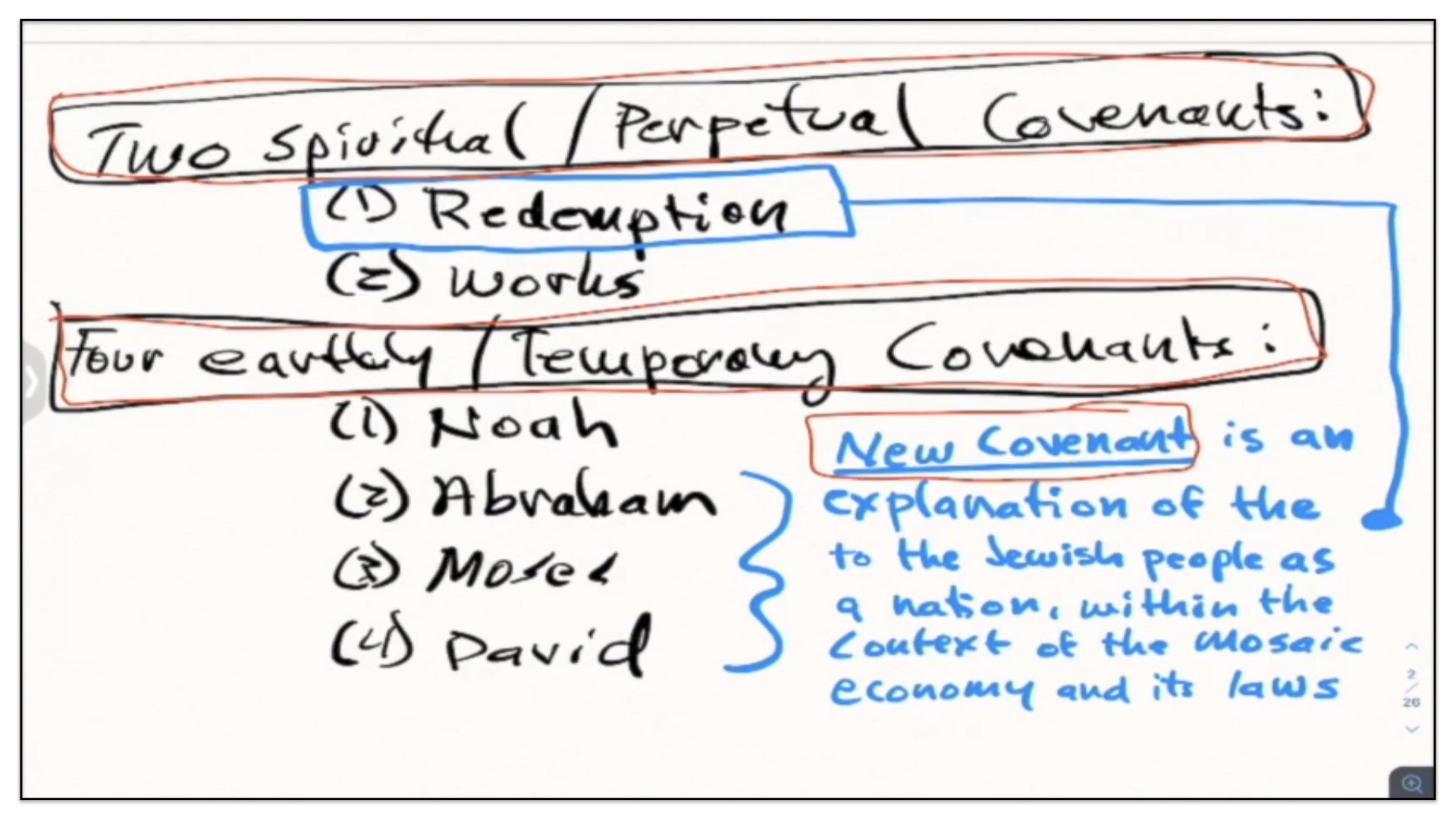
Now, as you know, I believe the covenants can be divided into one of two categories. First, there are two spiritual and perpetual covenants, that of Redemption and of Works. And then second, there are four earthly and temporary covenants, that which God made with Noah, Abraham, Moses and David. Then of course, there is the New Covenant. I don’t believe the New Covenant is an actual covenant, but rather, it’s an explanation of the Covenant of Redemption to the Jewish people as a nation as they were then living under the authority of the Mosaic Covenant and its laws.
Now, in the previous weeks I have given some time to look with you at the two spiritual and perpetual covenants, along with the four earthly and temporary covenants, and now it’s my great joy to bring a dedicated study on the New Covenant.
The New Covenant Is An Explanation Of The Covenant Of Redemption To The Jewish People As A Nation While They Were Living Under The Mosaic Economy And Its Laws
Now once again, let me refer you to the notes so that you understand my meaning when I refer to the New Covenant. I don’t believe the New Covenant is a covenant God has made any point in history, but rather, it’s a label given by the Lord and His prophets and apostles and evangelists for the Covenant of Redemption, but with particular explanation to the Jewish people as a nation as they were then living under the Mosaic economy and its laws.
The Mosaic Economy And Its Laws Was A Code Of Conduct Designed For The Jewish People As A Nation
Now when I refer to the Mosaic economy and its laws, I’m speaking about that system of civil, social and religious order appointed by God for the Jewish people as a nation, requiring of them compliance and obedience to that system, or code of conduct. Now this system, or economy and its laws, was designed only for the Jewish people as a nation. And therefore they alone were given the privilege to live within the boundaries of that social and religious order.
A Timeline For The Jewish People As A Nation
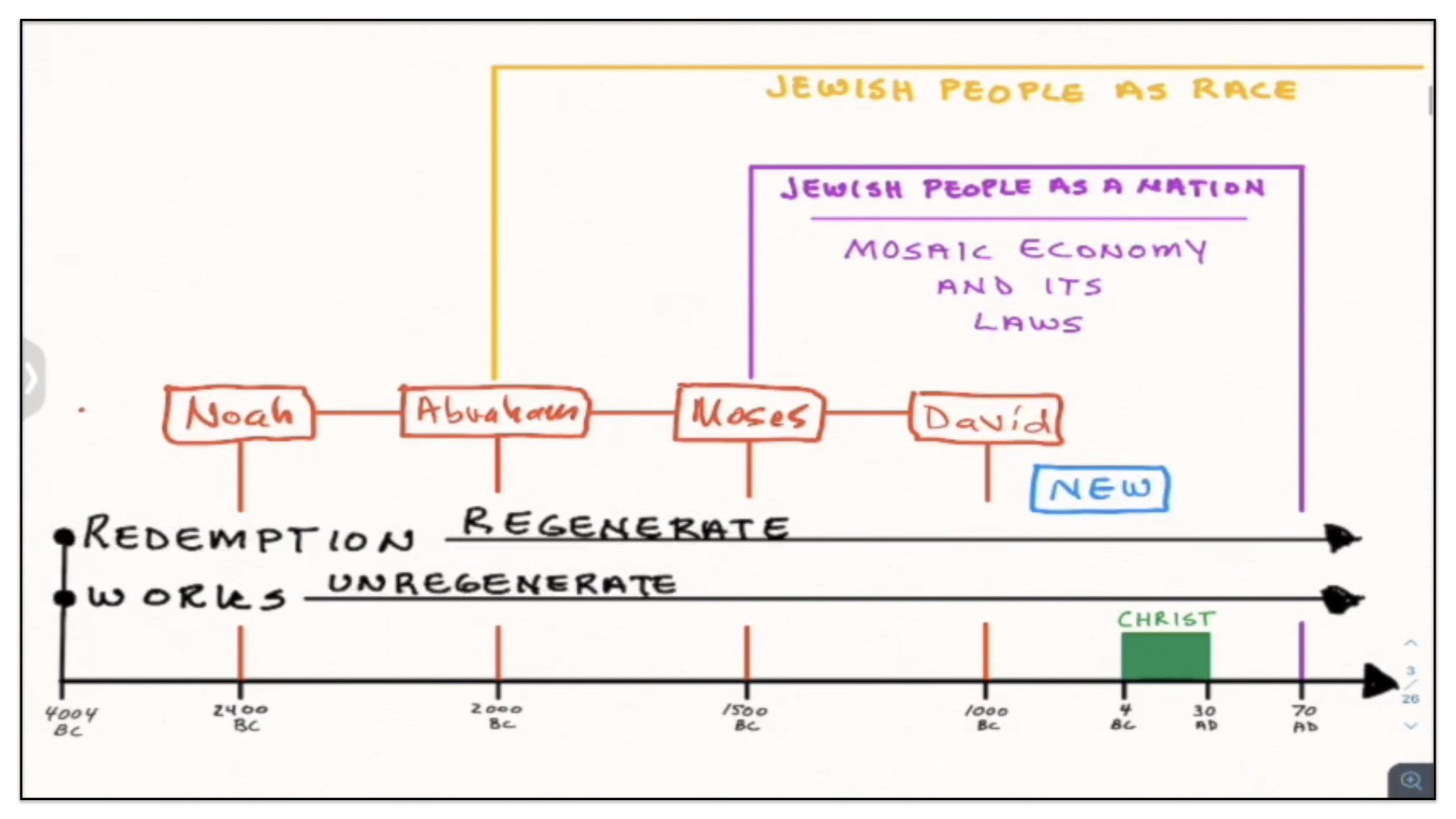
To help you better understand my meaning, allow me to refer you to a timeline and a diagram, and I’d like to use this as the backdrop to explain my view on the New Covenant.
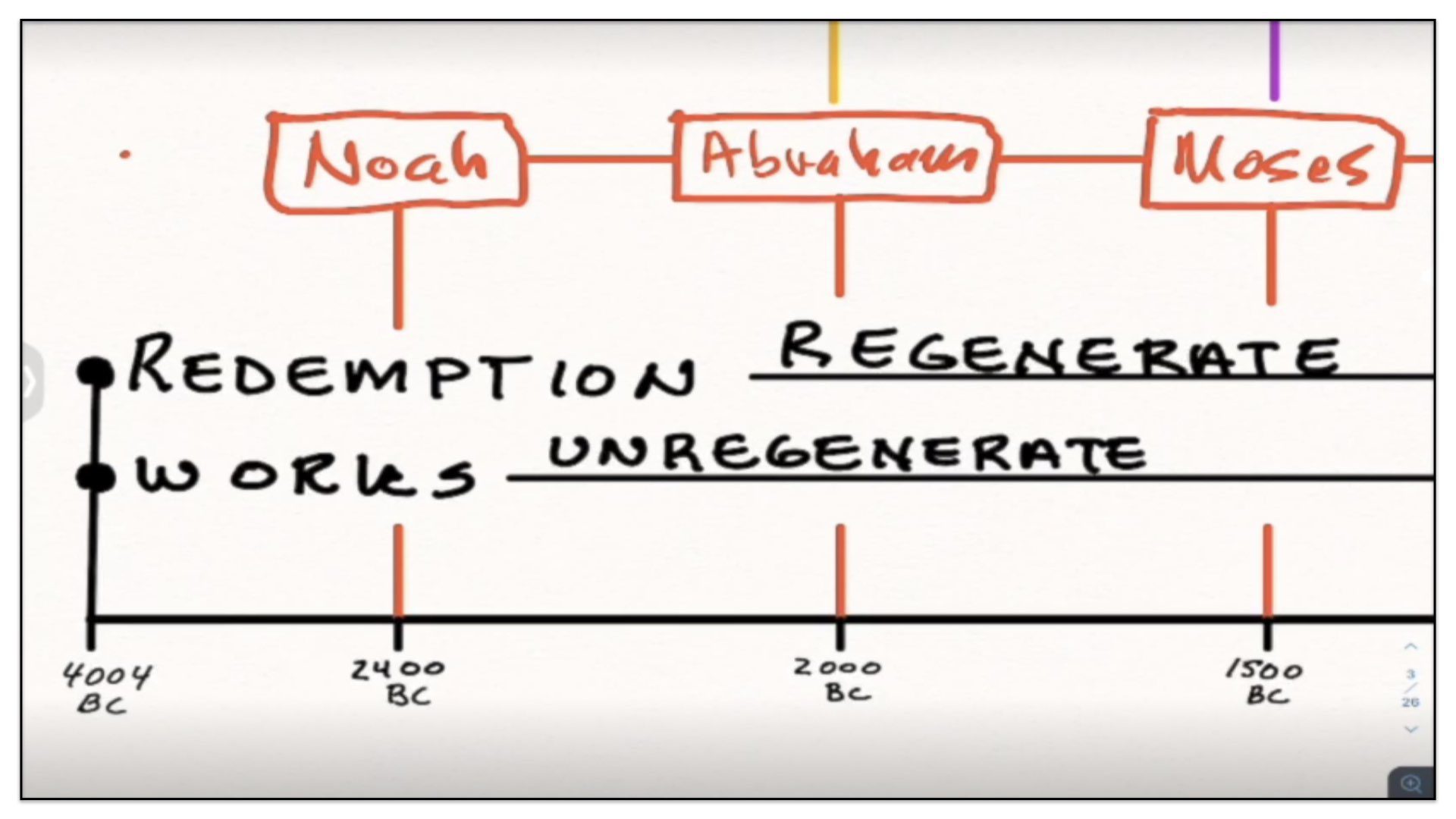
I’d like you to notice first, in black text, we have a reference to the two spiritual and perpetual covenants—that of Redemption, under which the regenerate are accountable unto God; and that of Works, under which the unregenerate are accountable unto God.
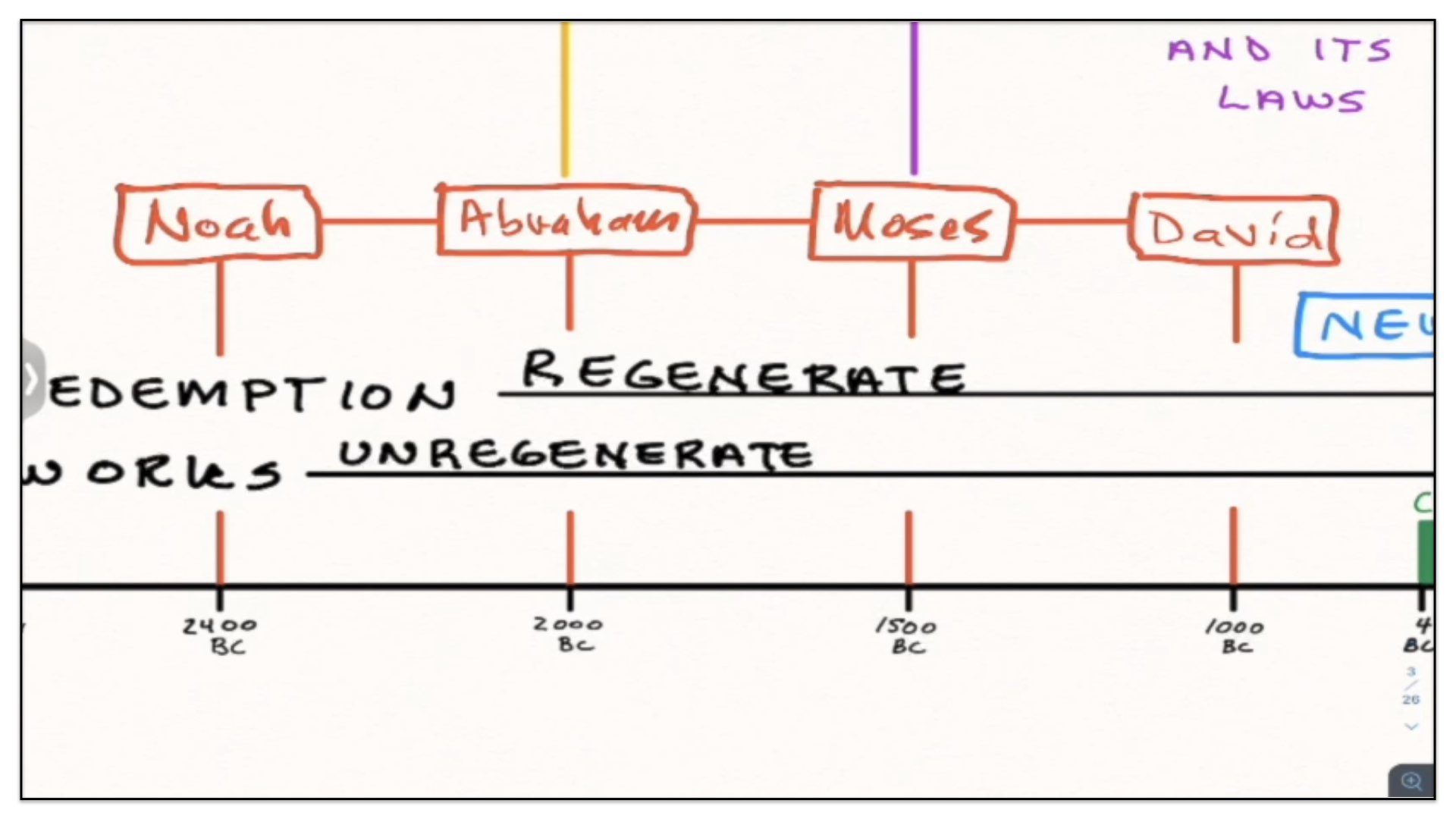
Then you’ll notice what we have in the red text is a reference to the four earthly and temporary covenants—that which God made with Noah, Abraham, Moses and David.
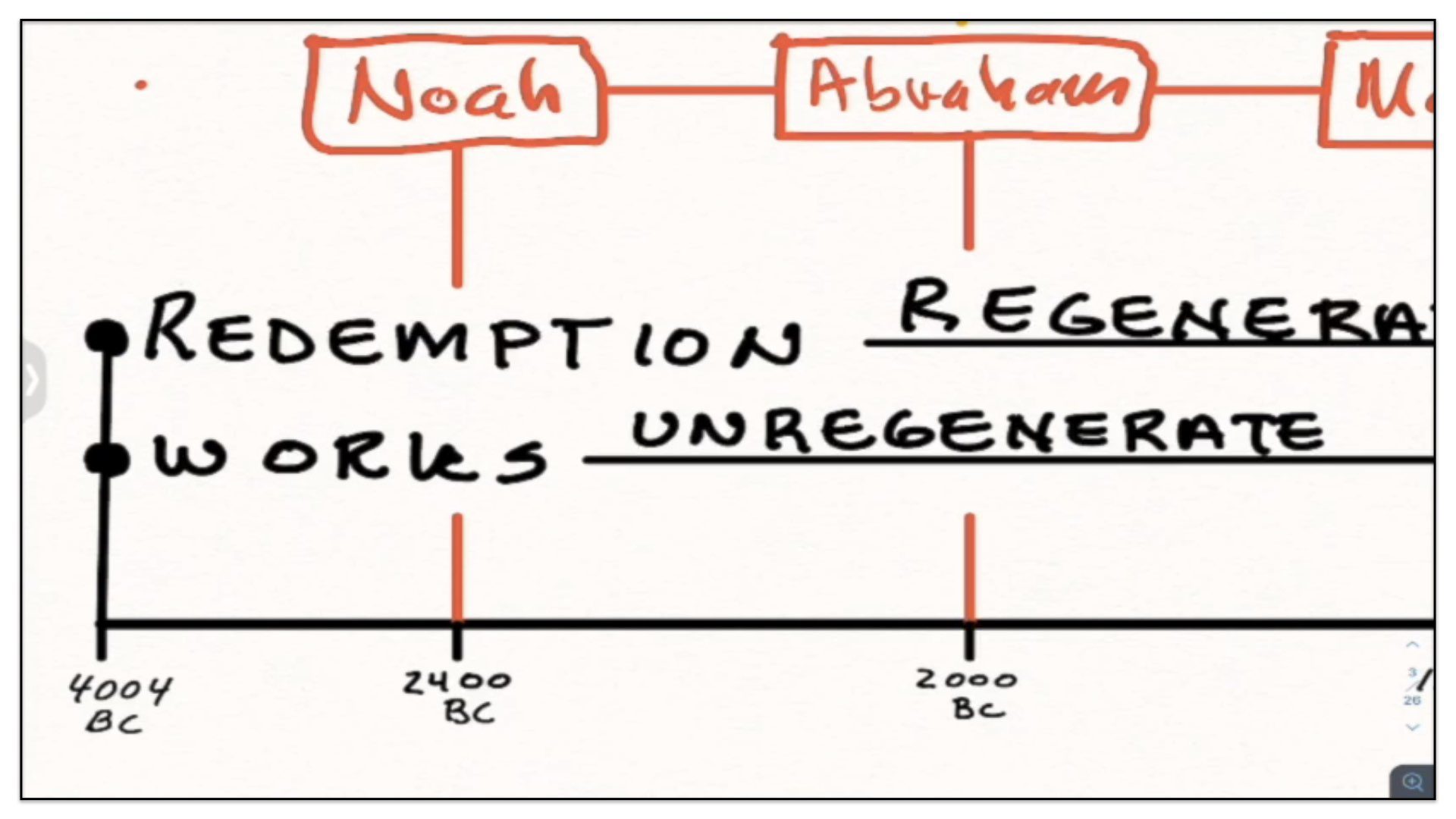
Also notice, along the timeline are a list of dates. Beginning with the first of these dates, 4004 BC—this represents the beginning when God made the heaven and the earth. The next date is 2400 BC—and this is the approximate year that God made this Covenant with Noah. The third date is 2000 BC—which is the approximate year God made this covenant with Abraham.
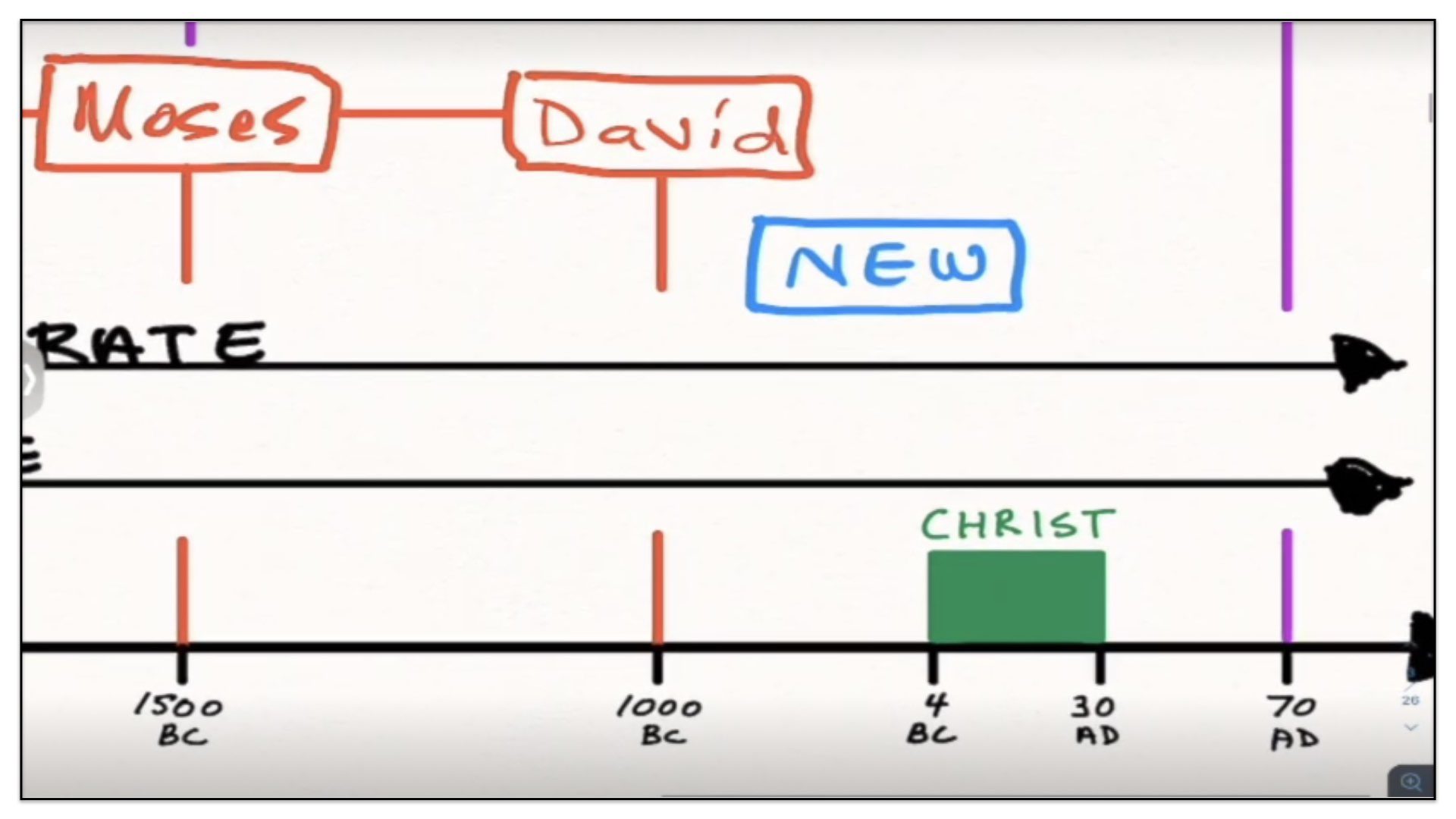
The next date to 1500 BC—which is the approximately year that God made this covenant with Moses. The next date is 1000 BC—this represents the approximate year that God made a covenant with David. And then of course in 4 BC—we have the year that the Messiah was born. And in 30 AD—is the approximate year that the Lord Jesus Christ was crucified, rose again and ascended into heaven. And the final date on the timeline is 70 AD—which represents the year Jerusalem was destroyed and marks the official end to the Jewish people as a nation.
The Difference Between The Jewish People As A Race And As A Nation
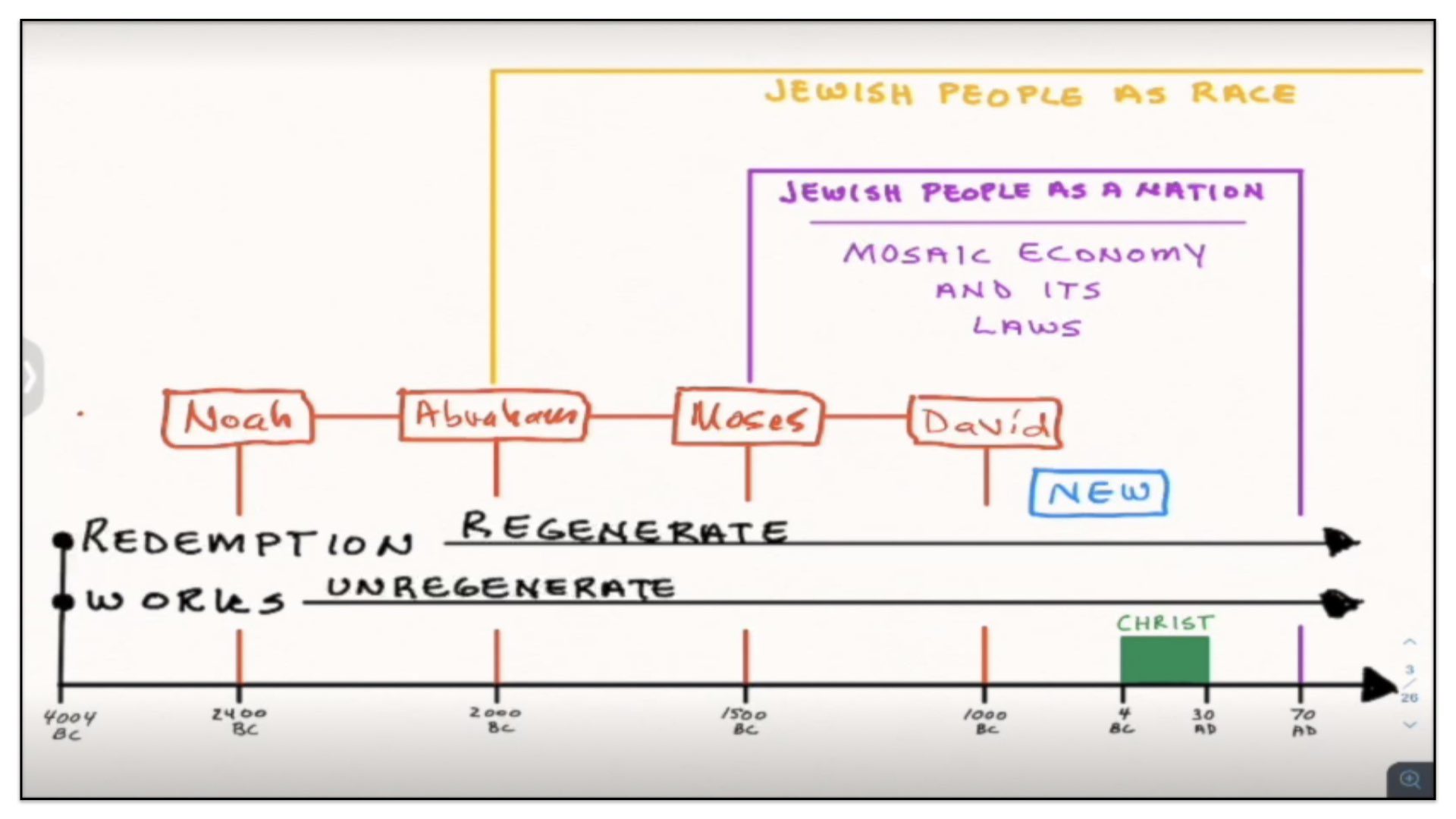
Now, having given to you this overview of the timeline and its dates, I’d like to say something more specific to you about the Jewish people as a race and also about the Jewish people as a nation, and you’ll see from the diagram, I distinguish between those two. I’d like you to notice, everything in yellow text represents the origin and continuance of the Jewish people as a race. Now the Hebrew race or the Jewish people, terms I use interchangeably, it began with Abraham around the year 2000 BC. Approximately 500 years later, the Jewish people were constituted by God a nation under the leadership of Moses. And that brings us then to the purple text. The purple text represents the origin and duration of the Jewish people as a nation. Now that nation is known as Israel, the nation of Israel. It receives its name after Abraham’s grandson Jacob, whose name was changed to Israel. And Jacob’s twelve sons became known as the twelve tribes—they were the heads of the twelve tribes of Israel, which during the days of Moses was constituted into a nation. Henceforth, the twelve tribes of Israel, making up the nation of Israel. Now, the nation of Israel continued for the next 1500 years, from the time of Moses to the year 70 AD, when as I’ve said, God brought an end to the Jewish people as a nation.
The Jewish People As A Nation Were Alone Given The Privilege To Live Within The Boundaries Of The Mosaic Covenant And Its Laws
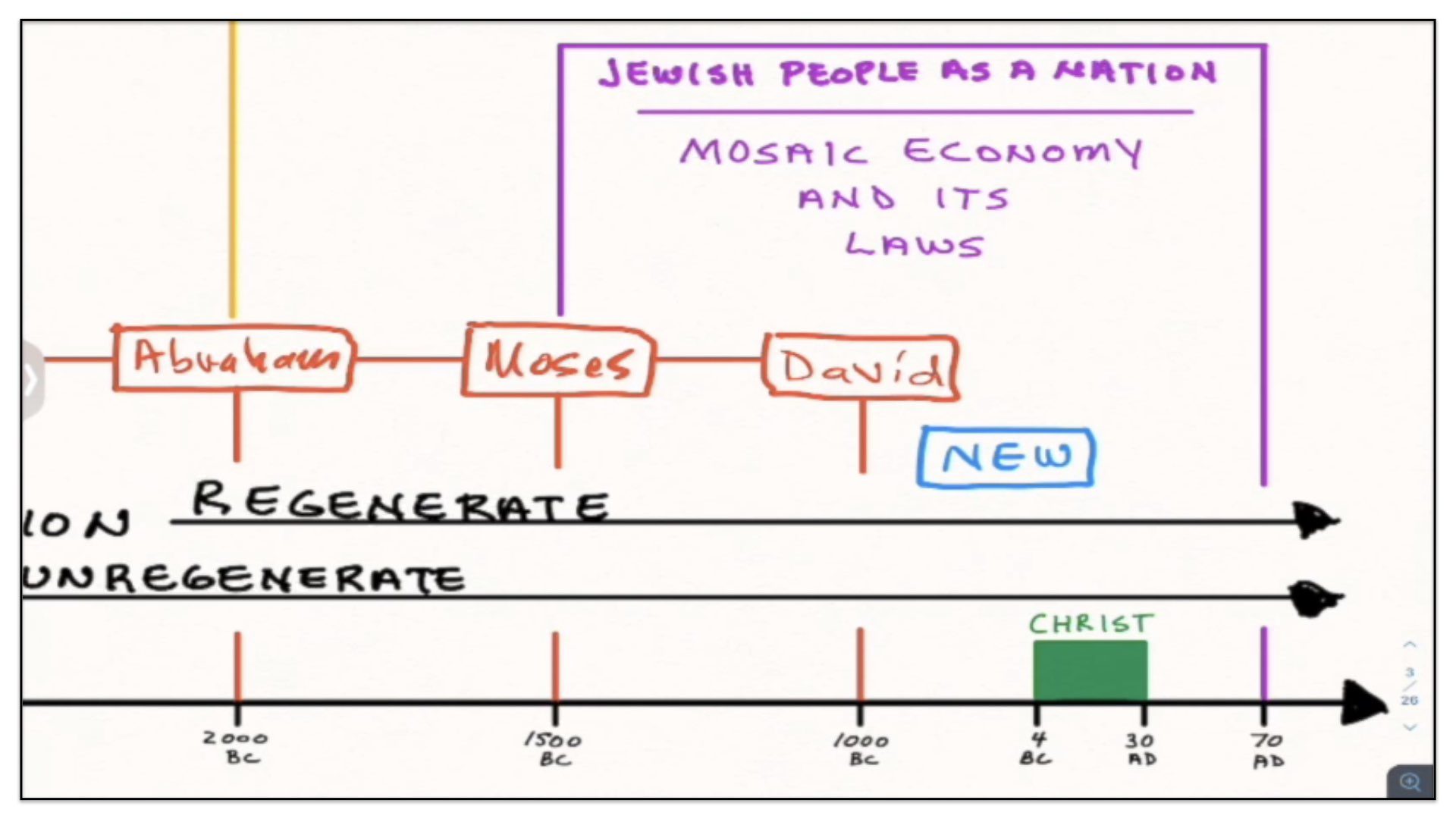
Now, it’s within this time period, between 1,500 BC and 70 AD, that the Jewish people lived under the Mosaic economy and its laws. Henceforth, I say again, and please listen to me carefully, when I speak of the Mosaic economy and its laws, I’m speaking about that system of civil, social and religious order appointed by God for the Jewish people as a nation, requiring of them compliance and obedience to that system or code of conduct.
Now, this system or economy and its laws was designed only for the Jewish people as a nation. I’m emphasizing this point because it seems to fall on deaf ears and blind eyes. The Mosaic economy and its laws was designed by God for the Jewish people as a nation, and therefore they alone were given the privilege to live within the boundaries of that social and religious order.
The Lord Jesus Christ And The Writers Of The New Testament Scriptures Ministered At A Time When The Jewish People Still Existed As A Nation
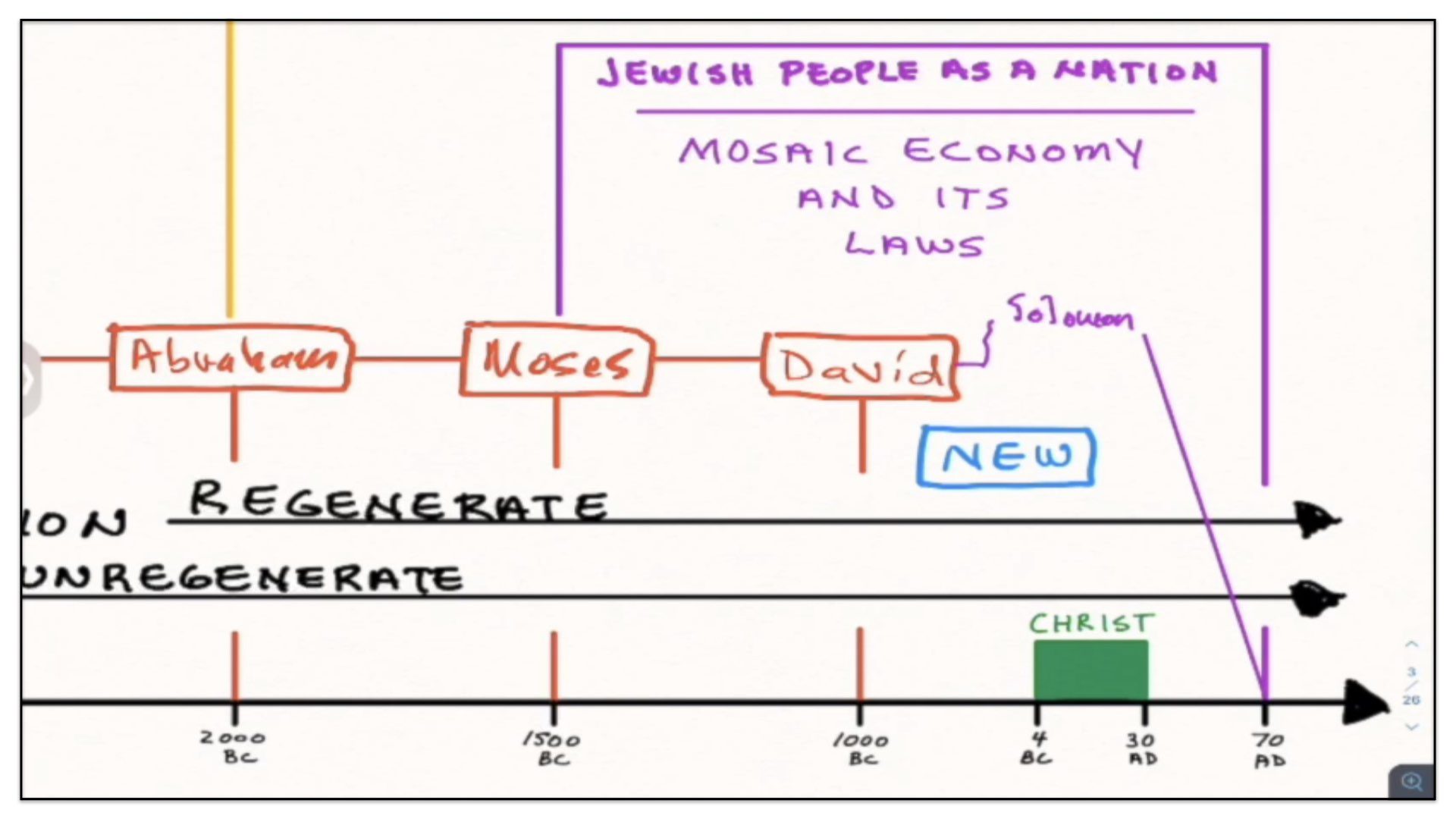
Now I would note the glory of Israel reached its zenith during the reign of King Solomon who followed David. And it was after the death of Solomon, which was around the year 975 BC, that a very slow but steady decline occurred where the nation of Israel would eventually end.
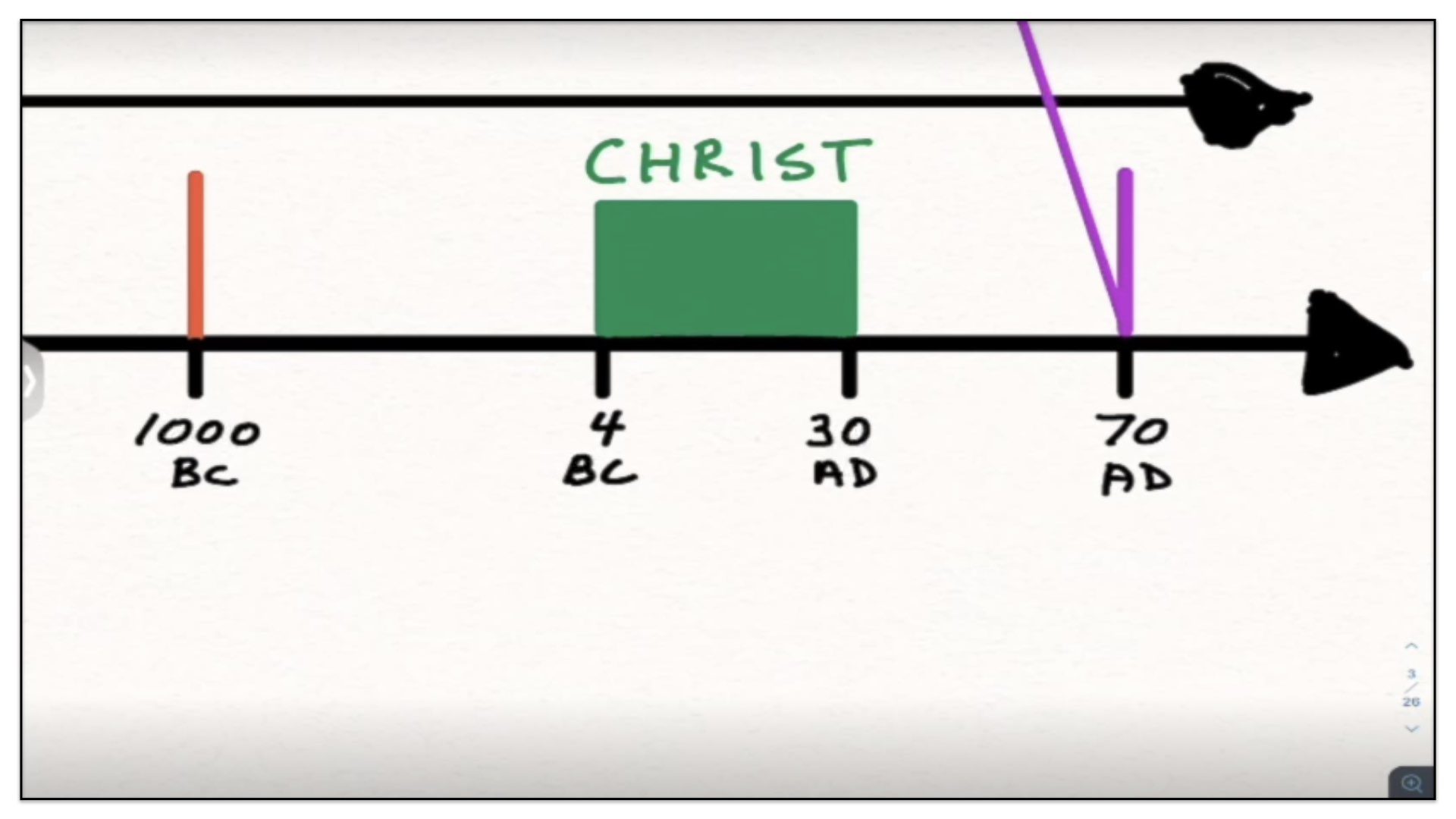
Now keeping all of this in mind, I’m going to refer you to the on-screen notes and magnify for you the specific dates between 30 AD and 70 AD. And the point I want to now emphasize is this—the New Testament scriptures fit within this context. I’d like you to think about that for a moment.
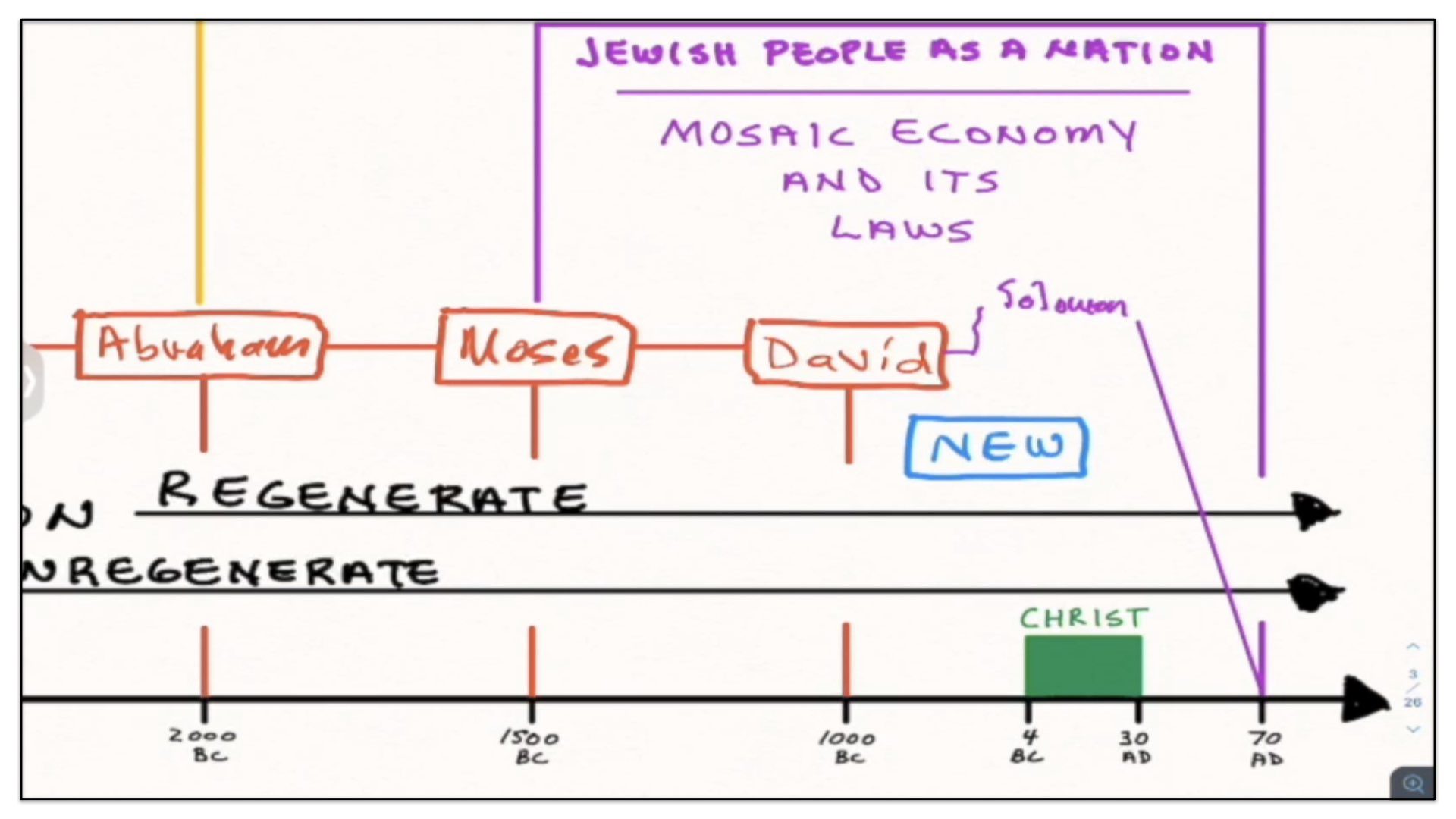
The New Testament scriptures were written during a time when the Jewish people as a nation were still in existence. This is a very important point when it comes to a consideration of the meaning of the various New Testament texts, when it comes to the subject of the New Covenant.
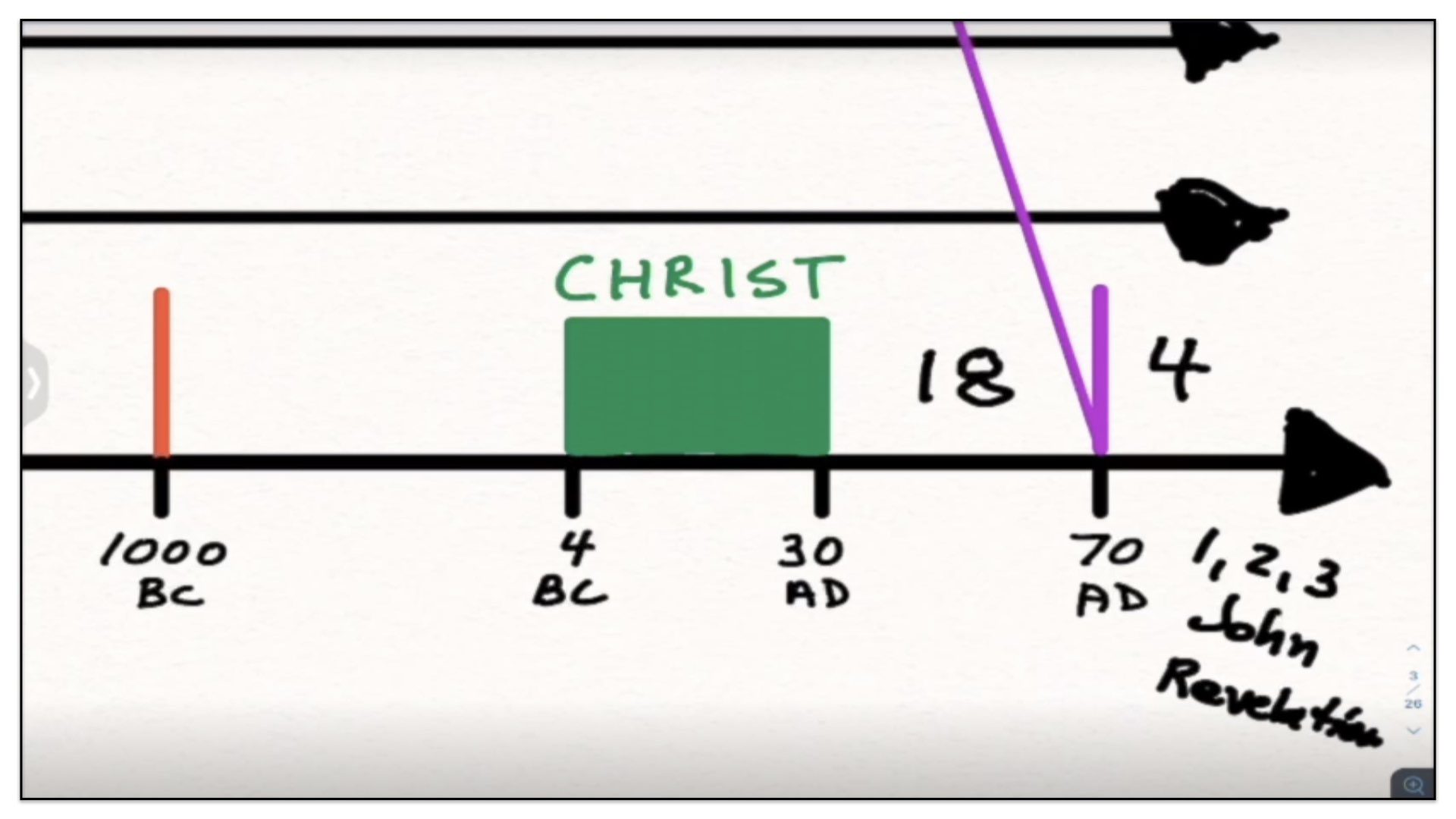
This is very interesting. Twenty-two letters comprise the New Testament scriptures. Twenty-two letters. Of these twenty-two letters, eighteen of them were written before the year 70 AD. Only four of them were written after the year 70 AD. Those that were written after the year 70 AD are 1, 2, 3 John and the book of Revelation.
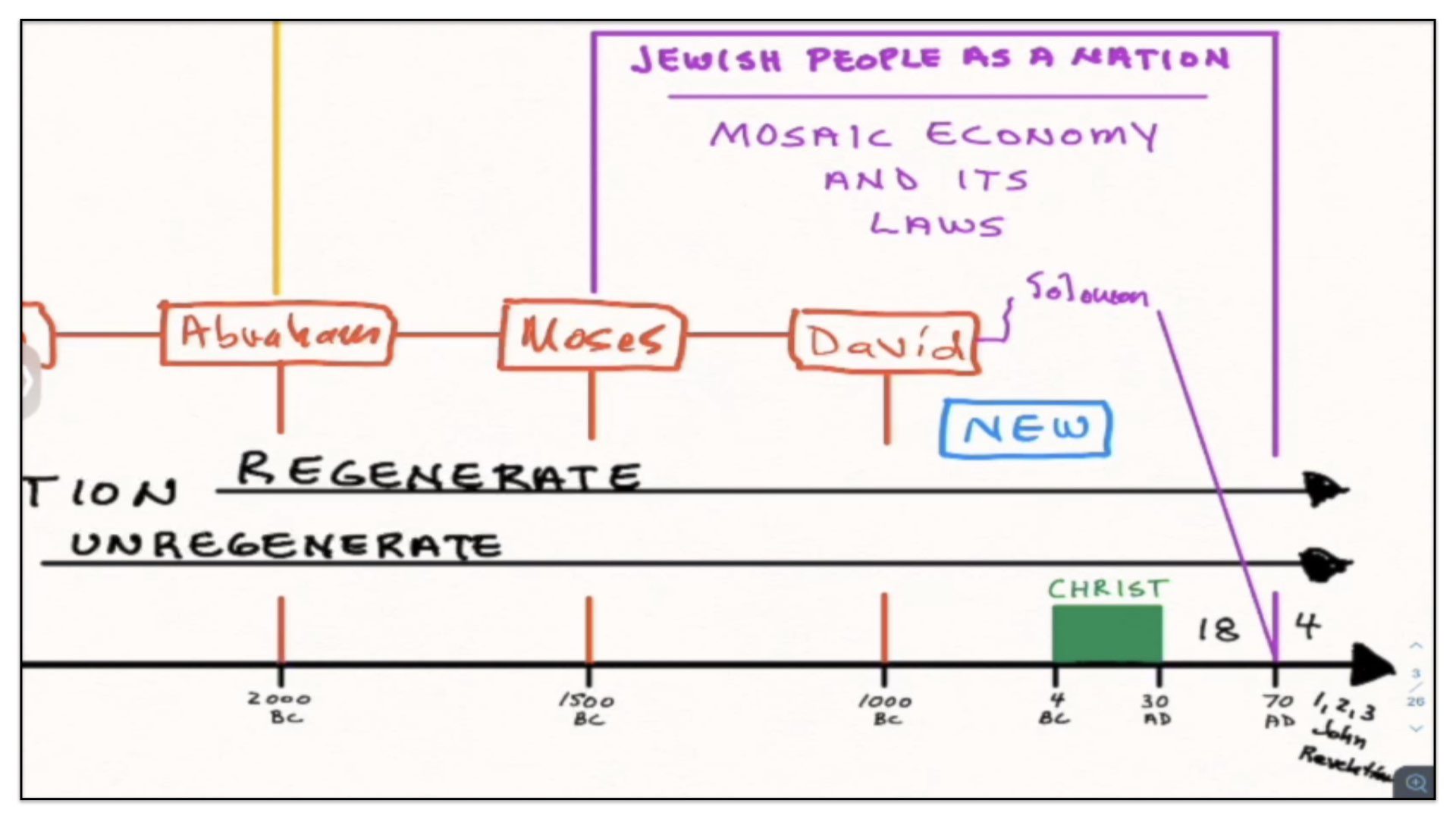
All of the other letters were written prior to 70 AD, which means they were written during a time when the Jewish people were still under the Mosaic economy and its laws.
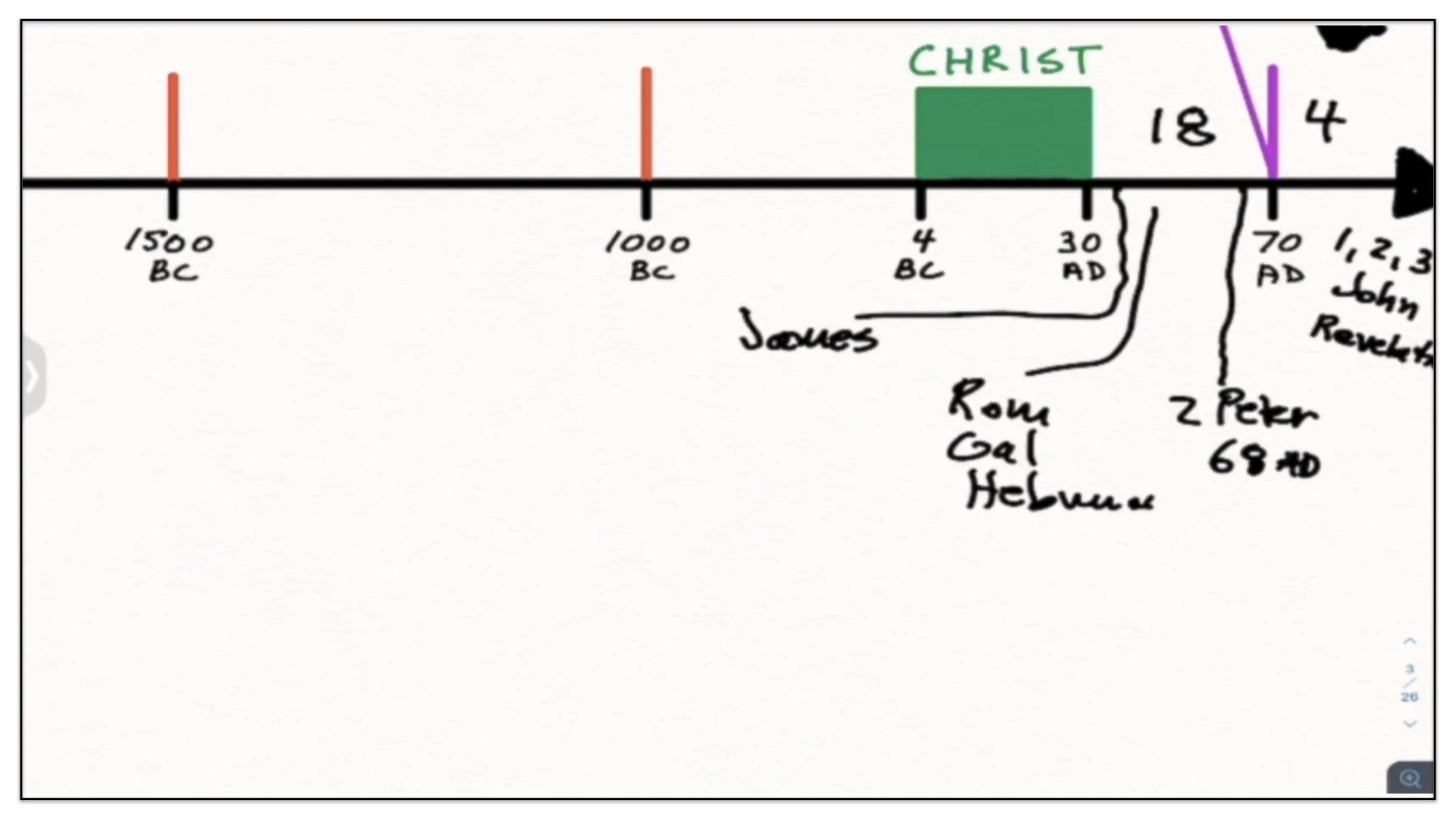
The earliest of these New Testament letters was written by James around the year 44 AD. And the last of these letters was written by Peter (2 Peter) around the year 68 AD. And between those letters, you’ve got all of the letters of Paul including that of Romans, Galatians and Hebrews.
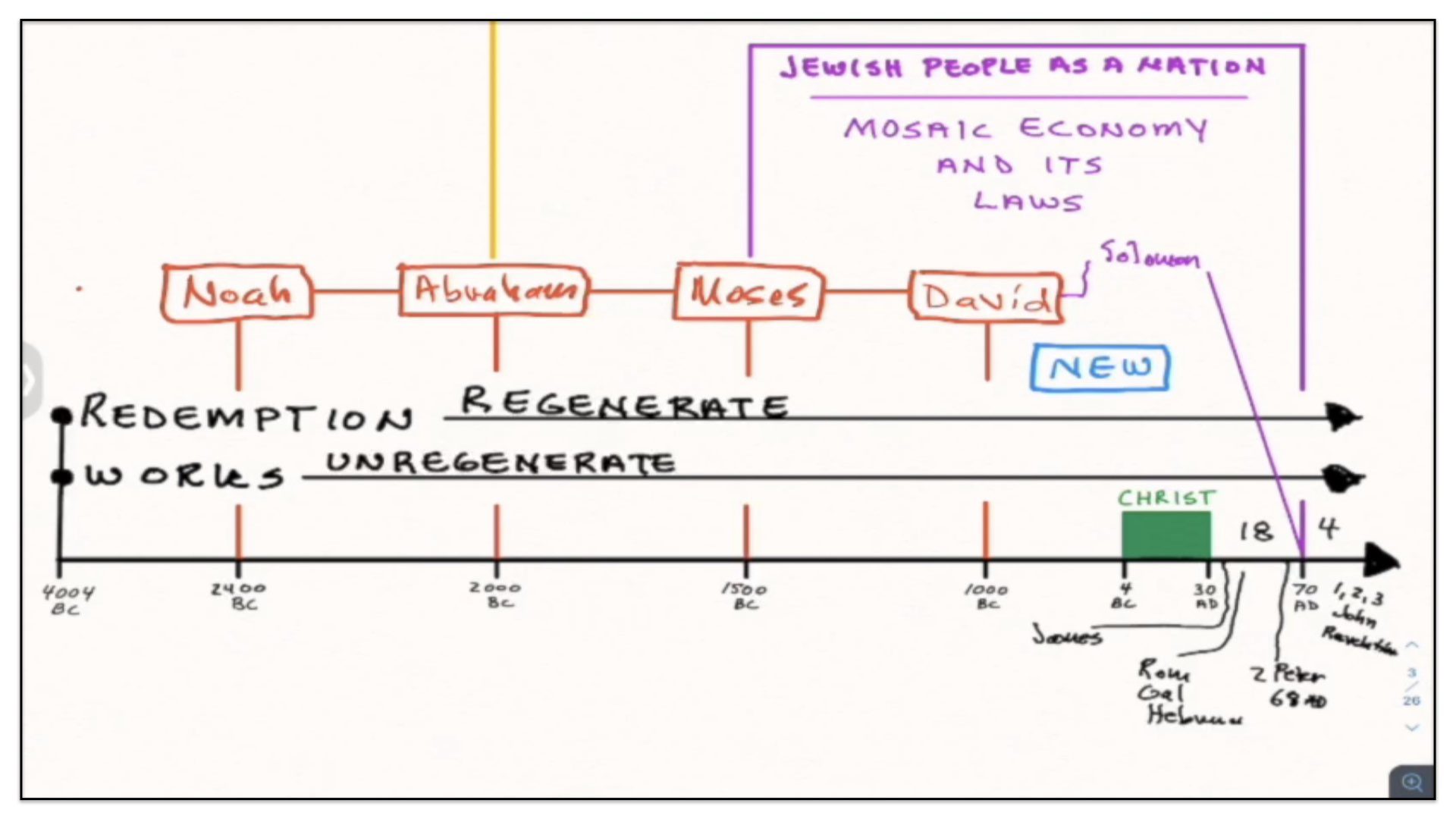
All of which explain the gospel to the Jewish people as a nation who were then under the Mosaic economy and its laws.
Now, of course, this is very important to keep in mind, because when Paul and Peter and James and Jude wrote their letters to the various churches of the New Testament era, they were writing to a mixed congregation of Jews and Gentiles. Those who were Jewish were technically still under the Mosaic economy and its laws. It was fading out by this point, but technically, it was still active. And the Apostles and Evangelists were teaching how through Christ the accomplishment of the second branch of the Covenant of Redemption, the Mosaic economy and its laws were coming to an end. But those who had been born again would remain connected with God in the sense that they were under a spiritual Covenant of Grace.
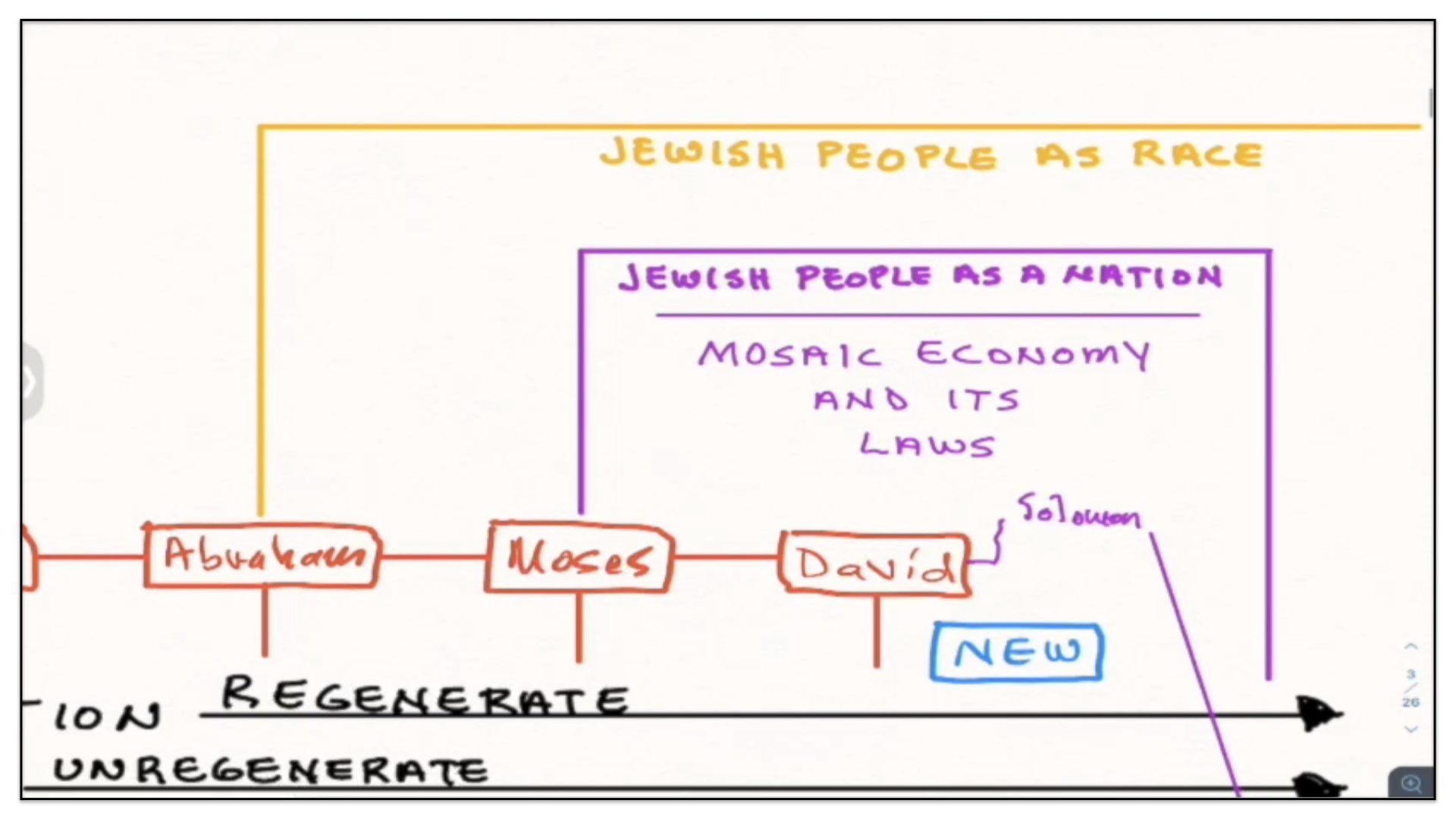
In fact, let me back up and just try to explain this a little bit more clearly to you. When the Apostles and the Evangelists wrote the letters to the New Testament churches, it was their purpose to explain to the Jewish people as a nation God’s purpose for them as a race, now that the nation was coming to an end. In other words, in the perspective of the Jewish people, their question was, “Is God going to cast us away now that our nation is ending and the Mosaic economy is terminating? Does God not have a purpose for us anymore?” And the answers of that question is this—while God is bringing an end to the Jewish people as a nation and to the Mosaic economy, yet He’s not bringing an end to the Jewish race.
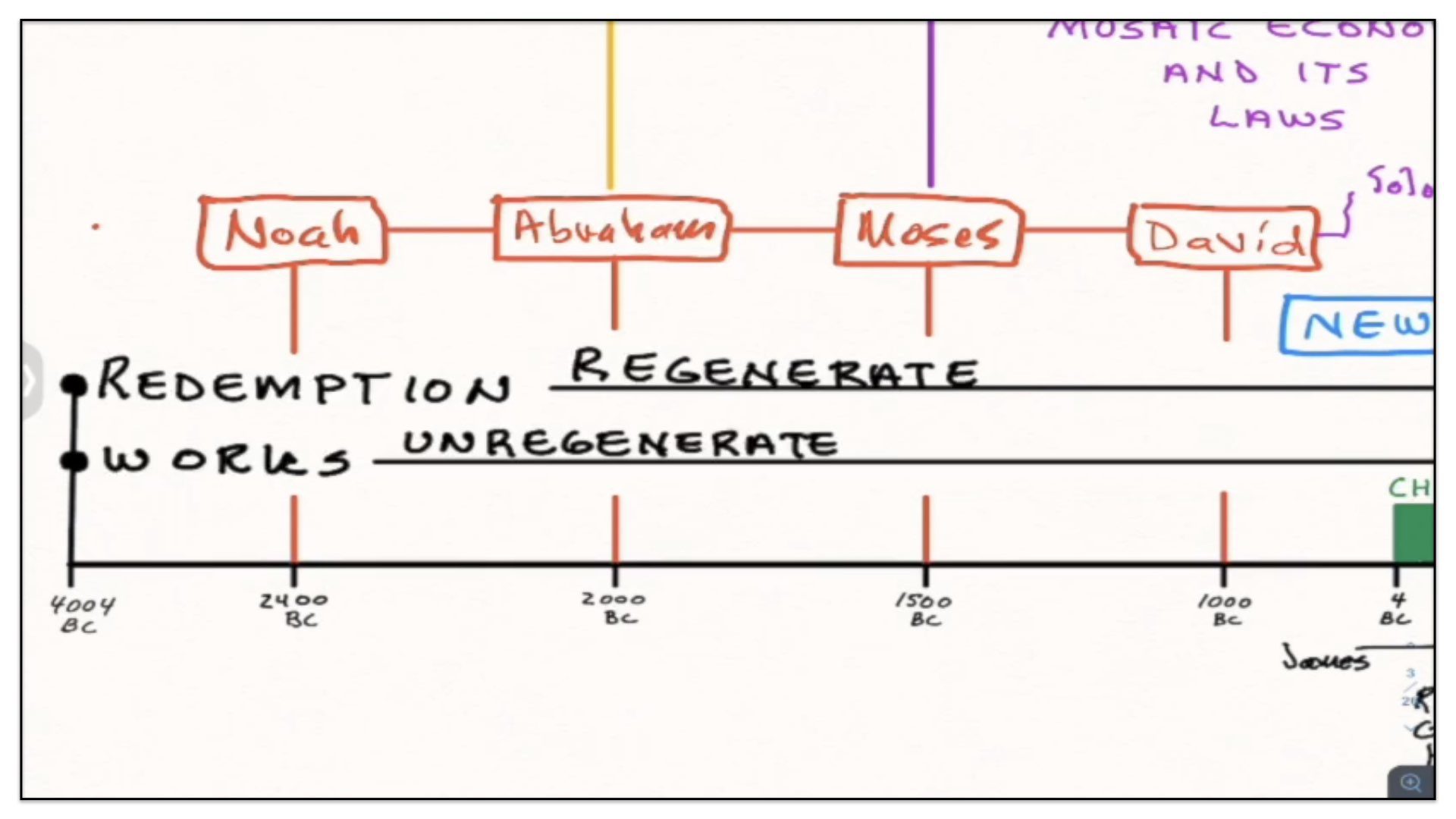
The Jewish race will continue and those within the Jewish race will be under one of these two perpetual covenants—that of Works or that of Redemption. Unregenerate Jews will be under the Covenant of Works and regenerate Jews will be under the Covenant of Redemption.
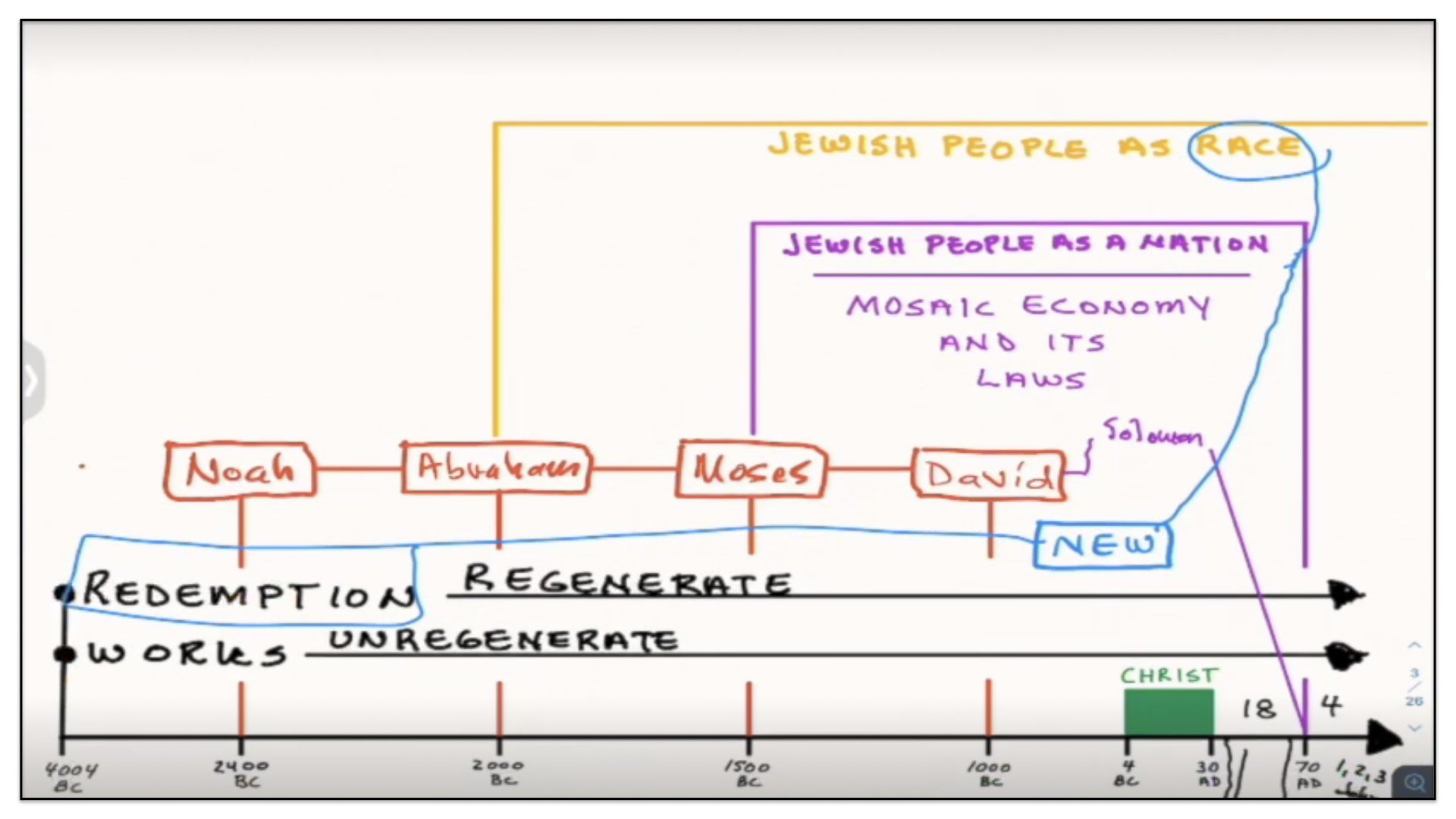
And you see, when the label is given, this label of a New Covenant, it’s given with reference to the Jewish people as a nation. And this is the Apostles and the Evangelists’ attempt to explain to the Jewish people as a nation the meaning of the Covenant of Redemption for them, the Jewish people as a race, now that the nation was coming to an end.
Now, of course, the Gentiles could learn from this. A Gentile is anyone who isn’t Jewish. A Gentile can learn from that also. But the New Covenant is technically an explanation, not to the Gentiles. They were not in need of that explanation because they were not under the Mosaic economy and its laws; it was the Jewish people that was under the Mosaic Covenant and its laws; and therefore technically, a reference to the New Covenant in the Word of God is a specific explanation to the Jewish people who were responsible to God under the Mosaic economy, so long as they were a nation.
Why Does Paul Argue In Hebrews That The Mosaic Covenant Has Already Ended, If The Jewish People As A Nation Were Still In Existence At That Time?
Now, I know you might be thinking, “Well, if the Jewish people as a nation ended in 70 AD, then why does Paul, for instance, argue in the book of Hebrews that the Mosaic economy has already ended with the death of Christ?”
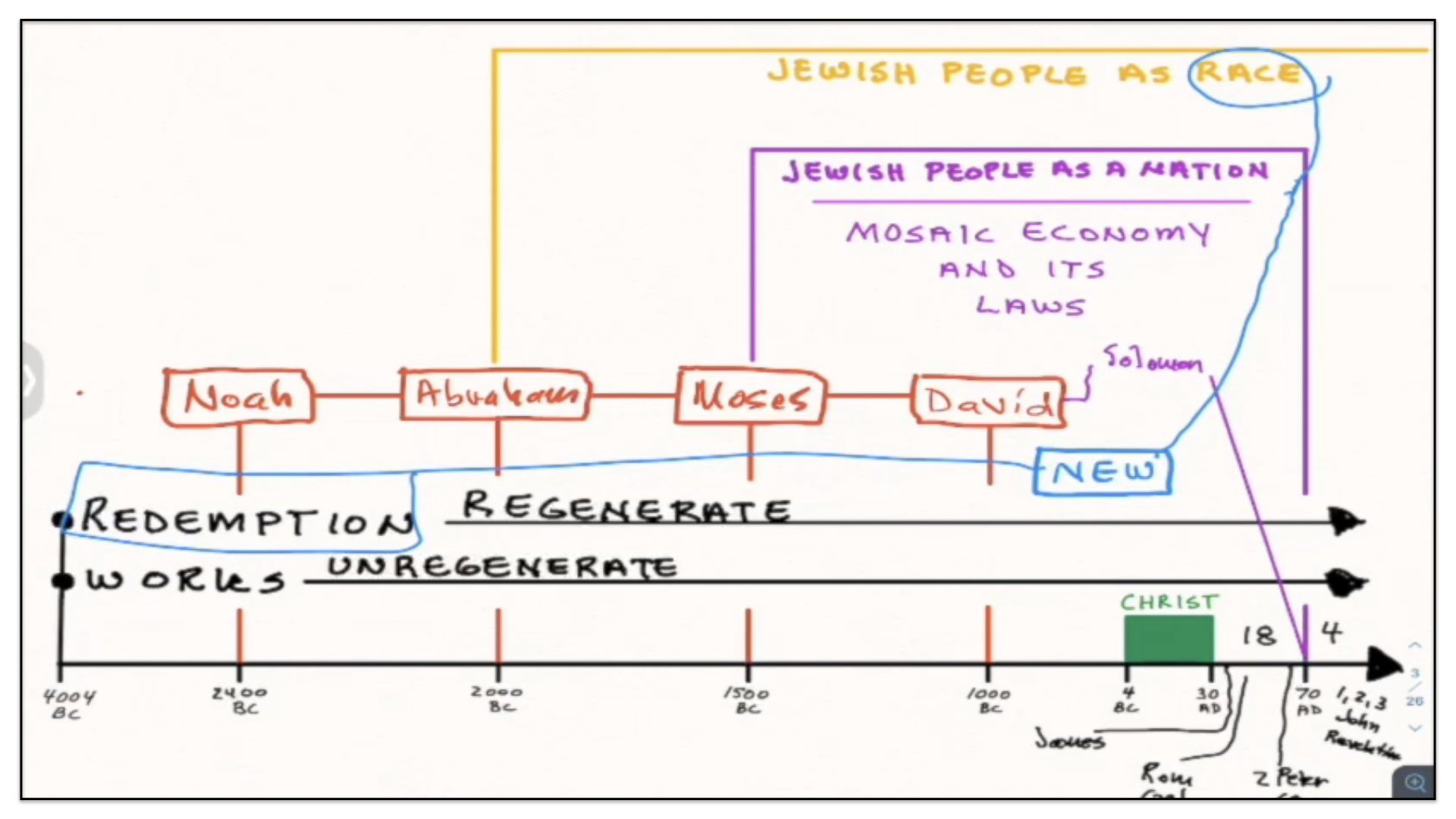
Well, my answer to that is that the nation was fading out along with the Mosaic economy and its laws. It didn’t come to an abrupt end when Christ died. It slowly faded away and I believe the final marker for the Jewish people as a nation was the year 70 AD, with the destruction of Jerusalem. But it was right for the Apostle Paul in Hebrews to argue that the Mosaic economy had now ended for those that had been regenerated, because it was ending and in some sense it had ended now that Christ had come and was the substance of all of those pictures given of Christ under the Mosaic economy and the ceremonial laws.
The Biblical References To A New Covenant
Okay. Well, that’s my viewpoint on this matter when it comes to this subject of the New Covenant. What I’d like to do with the time we have remaining, I would like to share with you the references we find in the Old and New Testament scriptures to this expression, New Covenant. And I want to read to you those passages of scripture and I’ll make a few comments or explanations upon them in connection with this timeline and diagram I presented to you on on the screen. There’s eight references we have to a New Covenant in the scriptures. One of these references is recorded in the Old Testament, the other seven are recorded in the New Testament scriptures.
Jeremiah 31:31-34
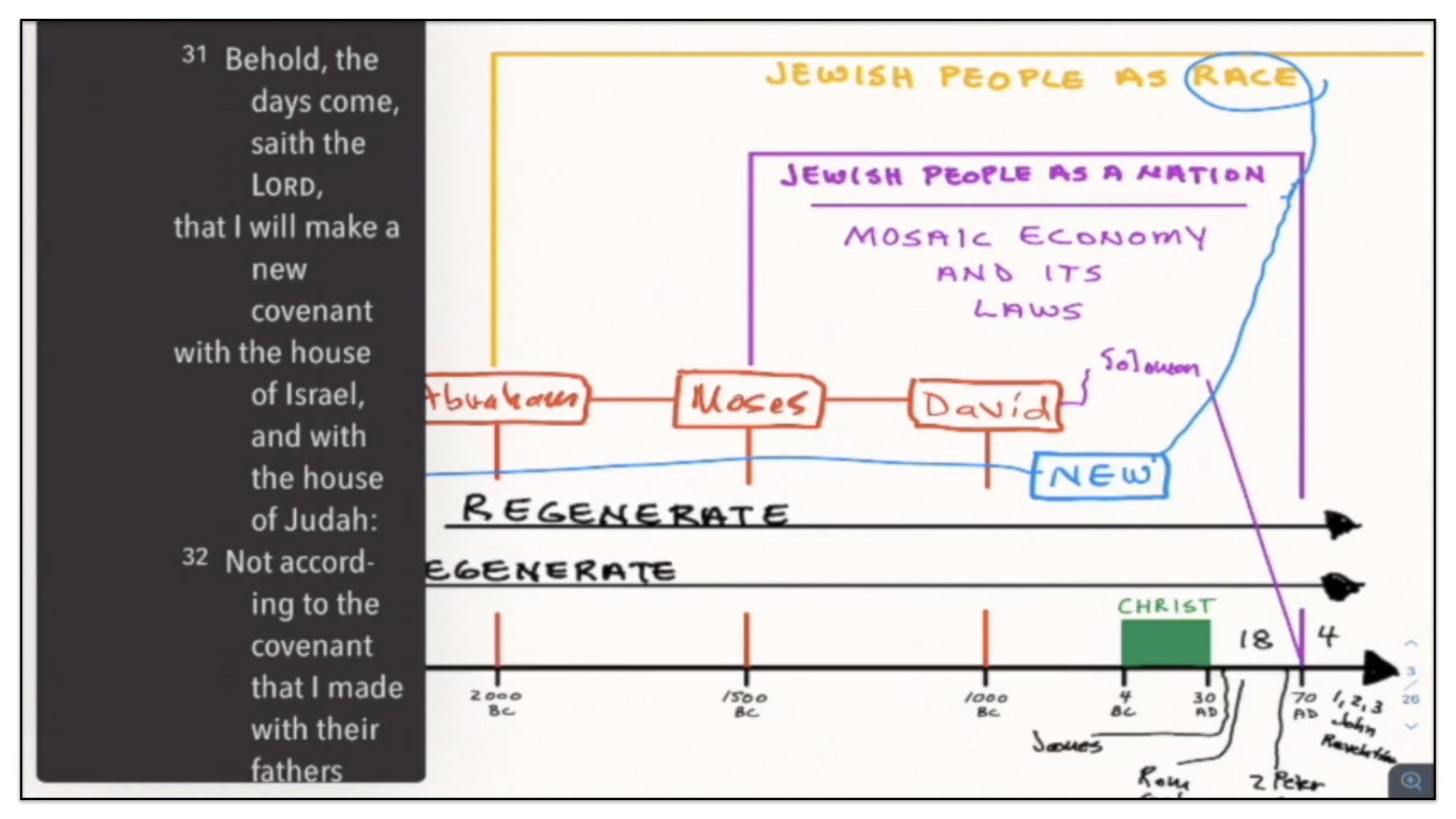
I’d like to read to you the first time we read this expression. As I’ve said it’s found in the Old Testament scriptures, and we’ll be looking in Jeremiah chapter 31 and I’d like to read for you verses 31 through 34. And as I read this passage to you, I’d like you to keep in mind the explanations I’ve just given regarding the New Covenant being an explanation within the context of the Jewish people as a nation. It’s an explanation of the Covenant of Redemption to them. Here’s the passage in Jeremiah chapter 31. I’ll begin reading in verse 31:
“Behold, the days come, saith the LORD,” So these are the words of the Lord recorded by the Prophet Jeremiah.
“that I will make a new covenant with the house of Israel,” There’s the expression—a New Covenant with the house of Israel.
“and with the house of Judah: not according to the covenant that I made with their fathers in the day that I took them by the hand to bring them out of the land of Egypt; which my covenant they brake, although I was an husband unto them, saith the LORD:” So now the Lord is comparing the Covenant of Redemption (He’s about to explain) with the Mosaic Covenant, or the Mosaic economy under which the Jewish people as a nation were then living. Verse 33:
“But this shall be the covenant that I will make with the house of Israel; After those days, saith the LORD,” Meaning, I believe, after the Jewish people as a nation cease to exist; after the death of Christ and in particular after the year 70 AD. The Lord says,
“I will put my law in their inward parts, and write it in their hearts; and will be their God, and they shall be my people.” In other words, God is saying to the Jewish people as a nation, He’s saying to them, Look, one day you are going to end as a nation and the Mosaic economy and its laws will be terminated, but don’t fret because the Covenant of Redemption is perpetual. And you see, the Lord highlights, the Lord highlights the third branch of the Covenant of Redemption—He says, “I will put my law into your inward parts and write it upon your hearts, and will be your God and you shall be my people.” Now that’s a reference to regeneration. It’s a reference to the sanctifying power of the Holy Spirit—this third branch of the Covenant of Redemption, when the Spirit of God unites the soul with the Lord Jesus Christ, by virtue of which the life and virtues of Christ flow into the soul making the sinner alive unto God and granting him or her the ability to savingly believe on the Savior. And this is writing that new law, or a new nature, granted us in Christ through this experience of the new birth. That’s all the Lord is here explaining to the Jewish people through the Prophet Jeremiah. He’s saying to them, Look the Covenant of Redemption will continue even when the Mosaic economy is terminated. And He goes on in verse 34:
“And they shall teach no more every man his neighbour, and every man his brother, saying, Know the LORD: for they shall all know me, from the least of them unto the greatest of them, saith the LORD:” Not simply saying that God will regenerate whom He pleases—those that the Father has chosen and given to His Son; the Spirit will regenerate all of His elect and redeemed people. And then references made to the second branch of the Covenant of Redemption, for the Lord says:
“for I will forgive their iniquity, and I will remember their sin no more.” Simply saying to the Jewish people as a nation, The Jewish people as a race will not be cast away, for numbered among the Jewish people as a race are those that are recipients of the Covenant of Redemption. And they have been truly redeemed by the blood of Christ, and their sins the Lord will not remember, for they are covered by the atoning blood of the Lord Jesus.
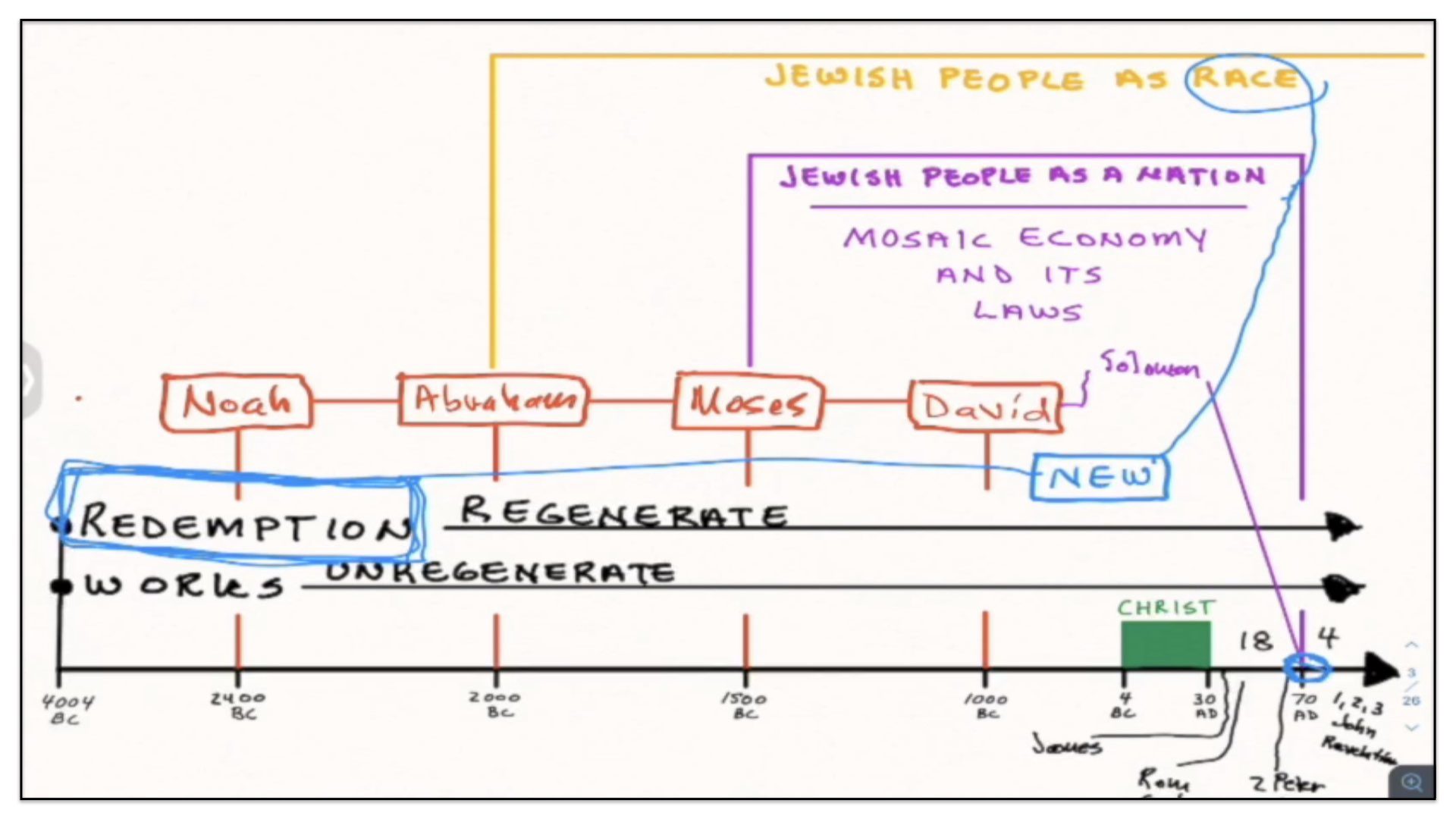
Now I hope you see, my dear friends, the points I’m making here with reference to the New Covenant. The New Covenant is not a New Covenant that God is going to establish in history with the nation of Israel, but rather, it is an explanation by God to the Jewish people as a nation of the Covenant of Redemption, encouraging the Jewish people that when their nation ceases to exist and the Mosaic economy and its laws are terminated, yet God will not cast away the Jewish people as a race, for there are numbered among them a remnant, the election of grace, whom the Son has redeemed by His blood and the Spirit of God will regenerate by His power. I believe that’s the meaning of Jeremiah chapter 31 verses 31 through 34.
Matthew 26:26-28; Mark 14:22-24; Luke 22:19,20; 1 Corinthians 11:23-35
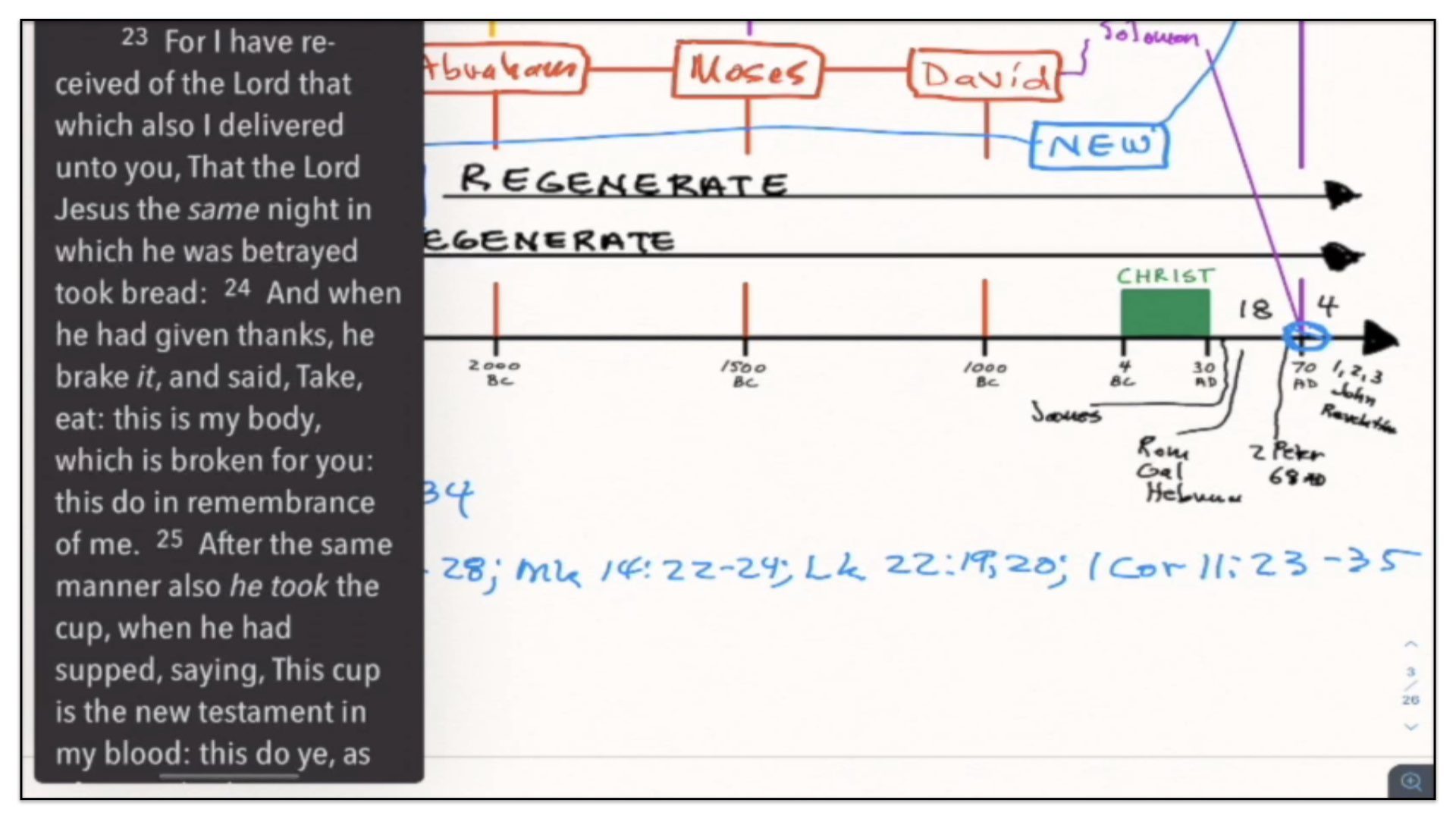
Well then, we might expect that if that’s the meaning of Jeremiah chapter 31, if this is the meaning of the New Covenant, then that meaning will continue to be the same when we read of this expression in the other parts of scripture. Well, let’s take a look at the next time we find this expression. We must turn to the New Testament scriptures for the next references and I’d like to now highlight for you the next four references to this language—the New Covenant. The next four references deal with the exact same event—that of the Lord Jesus Christ instituting the Communion Table and we have four references to this event. The first of these is found in Matthew chapter 26, verses 26 through 28. The second of these is found in Mark chapter 14, verses 22 through 24. The third is Luke chapter 22, verses 19 and 20. And then the fourth is First Corinthians chapter 11, verses 23 through 35. And as I’ve said, all of these passages refer to the same event—the institution of the Communion Table by the Lord Jesus Christ. There’s therefore no need for me to read all four of these passages. I’m just going to select one and I’ll read it as a representative of the other texts. The passage I’ve chosen to read is First Corinthians chapter 11. And it’s a good practice, if you have a copy of God’s Word, that you turn to the passage with me in your copy of the scriptures. First Corinthians chapter 11, and I’ll begin reading for you in verse 23. I’m not gonna read to the 35th verse. I’ll just read to verse 25. First Corinthians chapter 11, and I’ll commence reading in verse 23. The Apostle Paul wrote:
“For I have received of the Lord that which also I delivered unto you, That the Lord Jesus the same night in which he was betrayed took bread: And when he had given thanks, he brake it, and said, Take, eat: this is my body, which is broken for you: this do in remembrance of me. After the same manner also he took the cup, when he had supped, saying, This cup is the new testament in my blood:” There’s the language—the new testament. The word testament can also be translated covenant. It’s the same meaning. “This is the new covenant in my blood, this do ye, as oft as ye drink it, in remembrance of me.”
Now you’ll notice it’s the Lord Jesus Christ to employ this expression—the new covenant. And there’s no reason to understand the Lord’s use of this language to mean anything different from how the language is used in Jeremiah chapter 31. I mean, after all, in Jeremiah 31, it’s the Lord Himself using that language. And now in First Corinthians chapter 11, it’s the Lord Jesus Christ again using the same language. With reference to this particular event, the Lord Jesus Christ, as you’ll remember, is gathered in an upper room with His disciples. The first thing He does is He celebrates with them the passover. The passover, of course, if I take you back to the diagram, the passover points to the Mosaic economy and its laws. For at that time the Jewish people as a nation were still in existence and its covenant and its laws were active and therefore Jesus was observing the passover with His disciples. But the second thing the Lord does is entirely new. He institutes a new ceremony, an ordinance, that was to be observed by His church. This was completely separate and apart from the national covenants and laws of Israel. The communion table was designed to commemorate the redeeming grace of the Lord Jesus Christ which of course is the second branch of the Covenant of Redemption. And this is the reason, I’m arguing, this is the reason why the Lord Jesus Christ calls the cup that we partake “the cup of the new testament,” or the new covenant. The Lord Jesus Christ, when instituting the Lord’s table, is explaining to His disciples—they were mainly Jews—He was explaining to them the Covenant of Redemption, the second branch of the Covenant of Redemption, showing to them that it’s through His atoning blood, through His death, that God forgives iniquities and remembers the sins of His people no more.
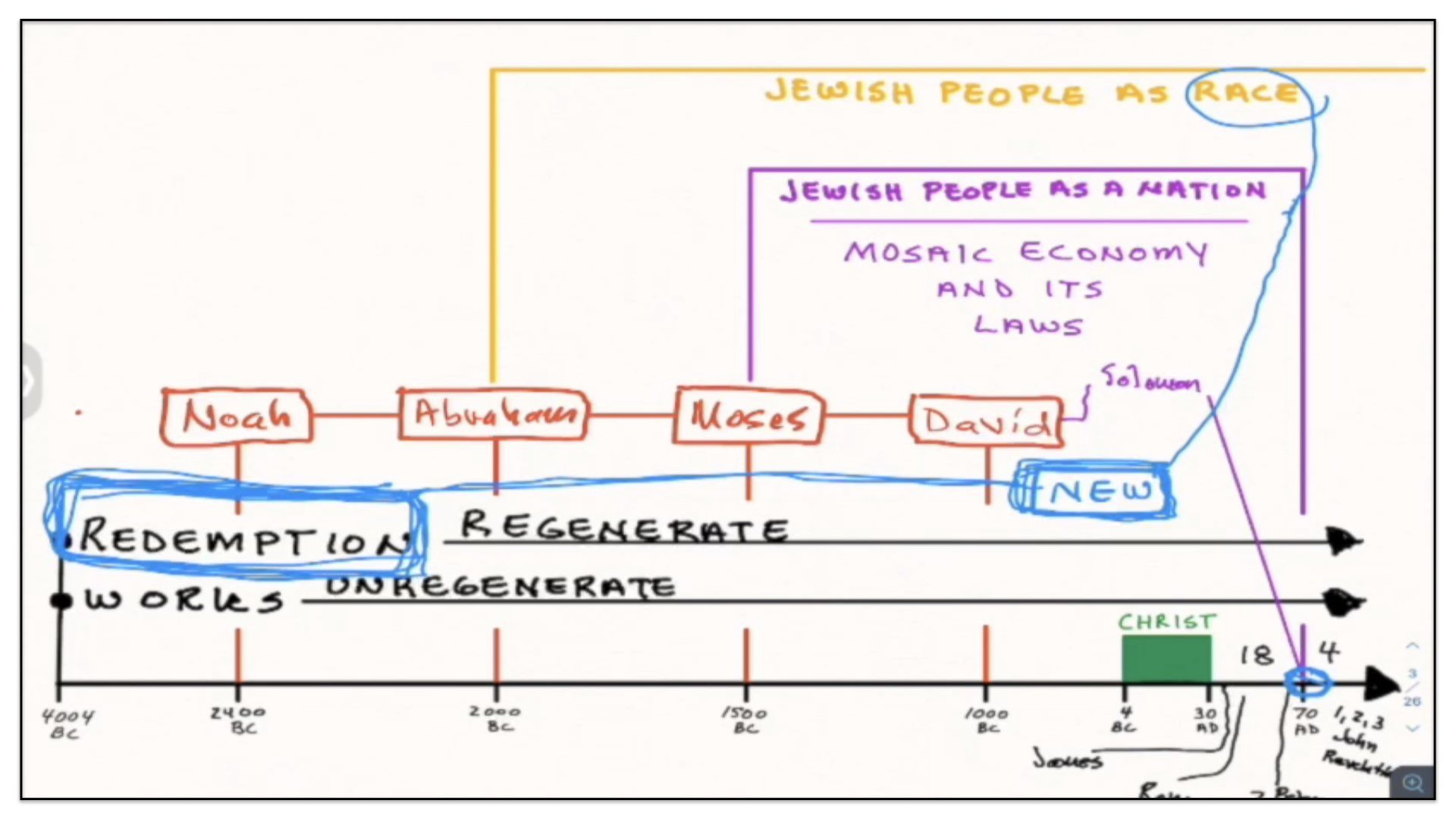
And you see, that’s the whole point I’m trying to say to you, that this reference to a new covenant is not the establishment of an actual covenant in history, but it’s merely an explanation of the Covenant of Redemption to the Jewish people as a nation who were then living under the Mosaic economy and its laws.
Okay. So of the eight scriptural passages which refer to a New Covenant, I’ve shown to you that the first five references are using it as a label to explain the Covenant of Redemption to the Jewish people as a nation, who were at that time under the Mosaic economy and its laws. Let’s now come to the next time we find this expression used in the New Testament.
2 Corinthians 3:5,6
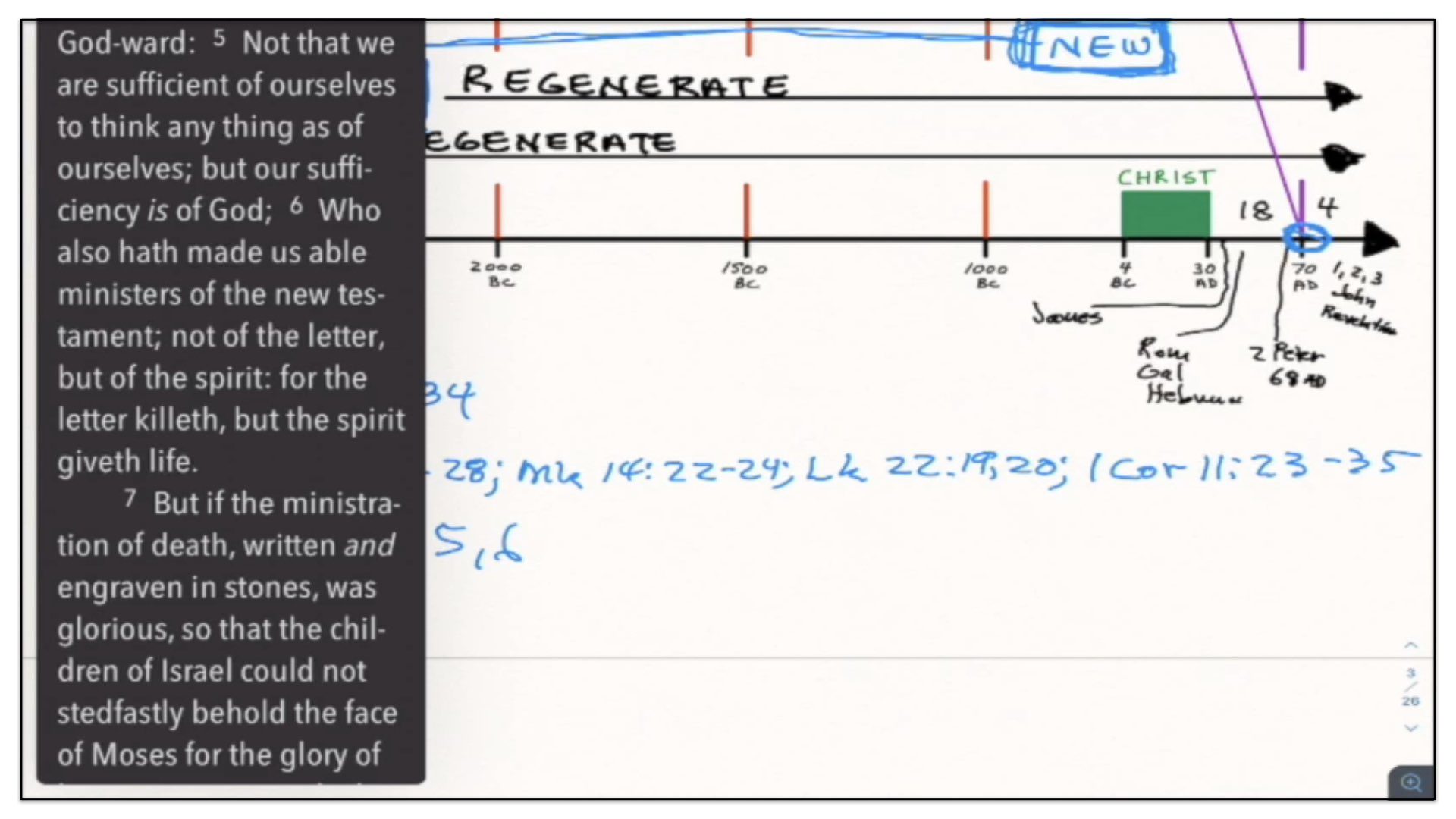
It’s used again by Paul and this time in Second Corinthians chapter 3, and verses 5 and 6. Again, if you have a copy of God’s Word, turn with me to this passage. Second Corinthians chapter 3, and I’ll begin reading for you in verse 5:
“Not that we are sufficient of ourselves to think any thing as of ourselves; but our sufficiency is of God; who also hath made us able ministers of the new testament;” or new covenant; that’s the language; that’s the expression, “not of the letter, but of the spirit: for the letter killeth, but the spirit giveth life.”
Now I’ll have you notice first, that this is the first time the expression, new covenant, is used by someone other than the Lord Himself. Remember Jeremiah 31, it’s the Lord speaking that language and again in the first four references of the New Testament, it’s the Lord Jesus Christ using that language. But now for the first time we have the Apostle Paul borrowing this language and I believe he’s doing it and he’s using it in precisely the same way as the Lord did in the previous passages. In this particular text Paul acknowledges his inherent insufficiency to serve in this capacity as a gospel preacher. And he goes on to explain how he has been set apart by the Lord for this work. He’s been gifted and called by Christ, Who then, Paul says, by His, Christ’s own sufficiency of grace and power. It’s He who has made Paul an able or a capable minister or servant of the new covenant. So Paul identifies himself as a servant of the new covenant. Now I say, there’s no reason for us to understand Paul’s use of this language to mean anything different than that in how the Lord Himself used this label.
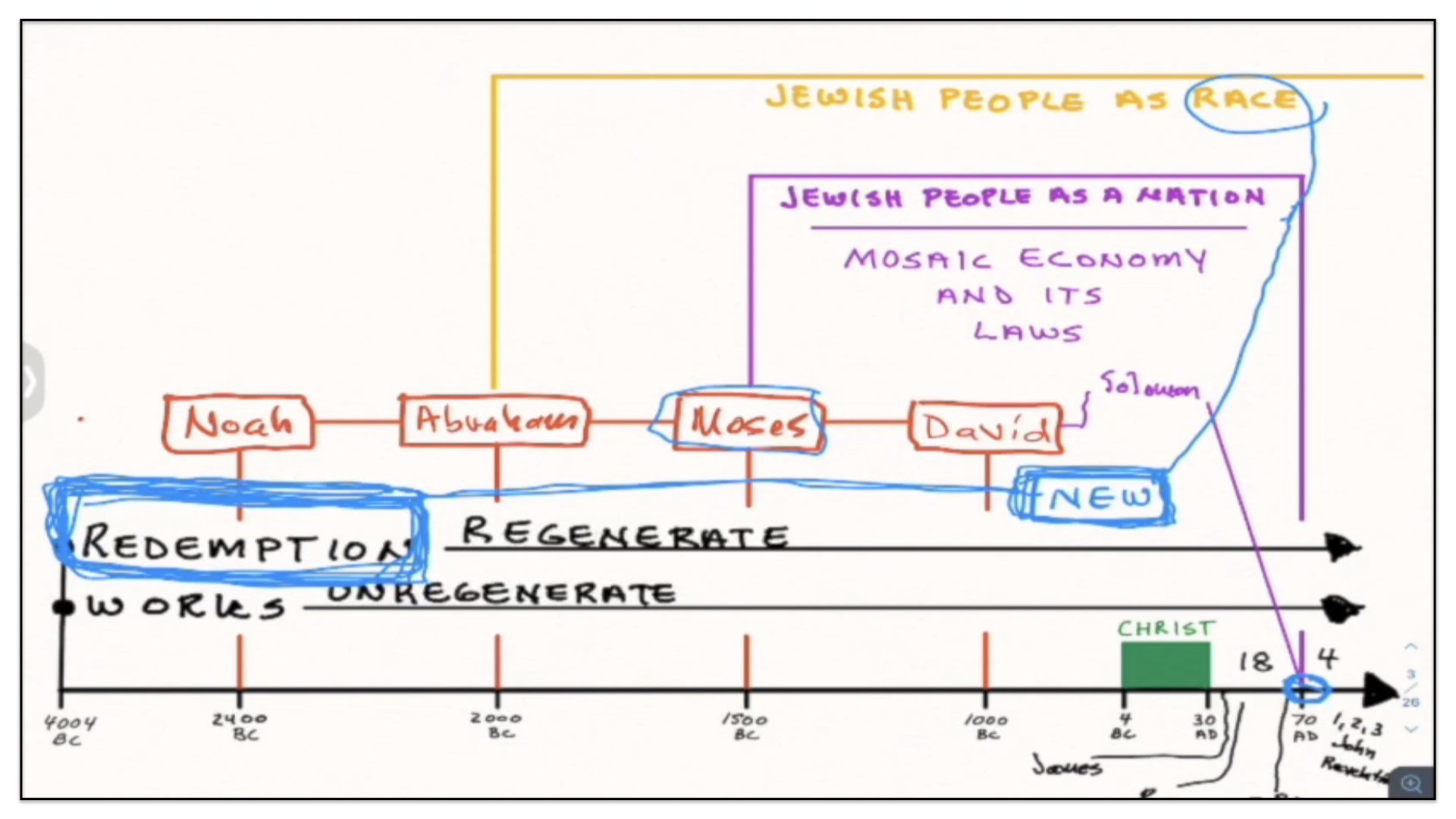
What does Paul mean by identifying himself as an able minister of the new covenant? Well, he means that Christ has called him to preach the unsearchable riches of redeeming grace, the second branch of the Covenant of Redemption. Paul goes on to explain the Covenant of Redemption is a very different thing from the Covenant of Moses. Very different. Paul argues the Mosaic Covenant is an earthly and temporary covenant and one that is of the letter only. It has no vital force or living energy. Whereas the Covenant of Redemption is a spiritual and perpetual covenant and one that is of the spirit. It is of a vital force and has life giving energy. It’s a life giving covenant. Now you see, Paul is not saying God has established an entirely new covenant, but rather, he is simply explaining to the Jewish people as a nation how the Covenant of Redemption, in particular the second branch of the Covenant of Redemption, differs from the covenant that God made with Moses and under which the Jewish people as a nation were then living.
Hebrews 8:1-10:39
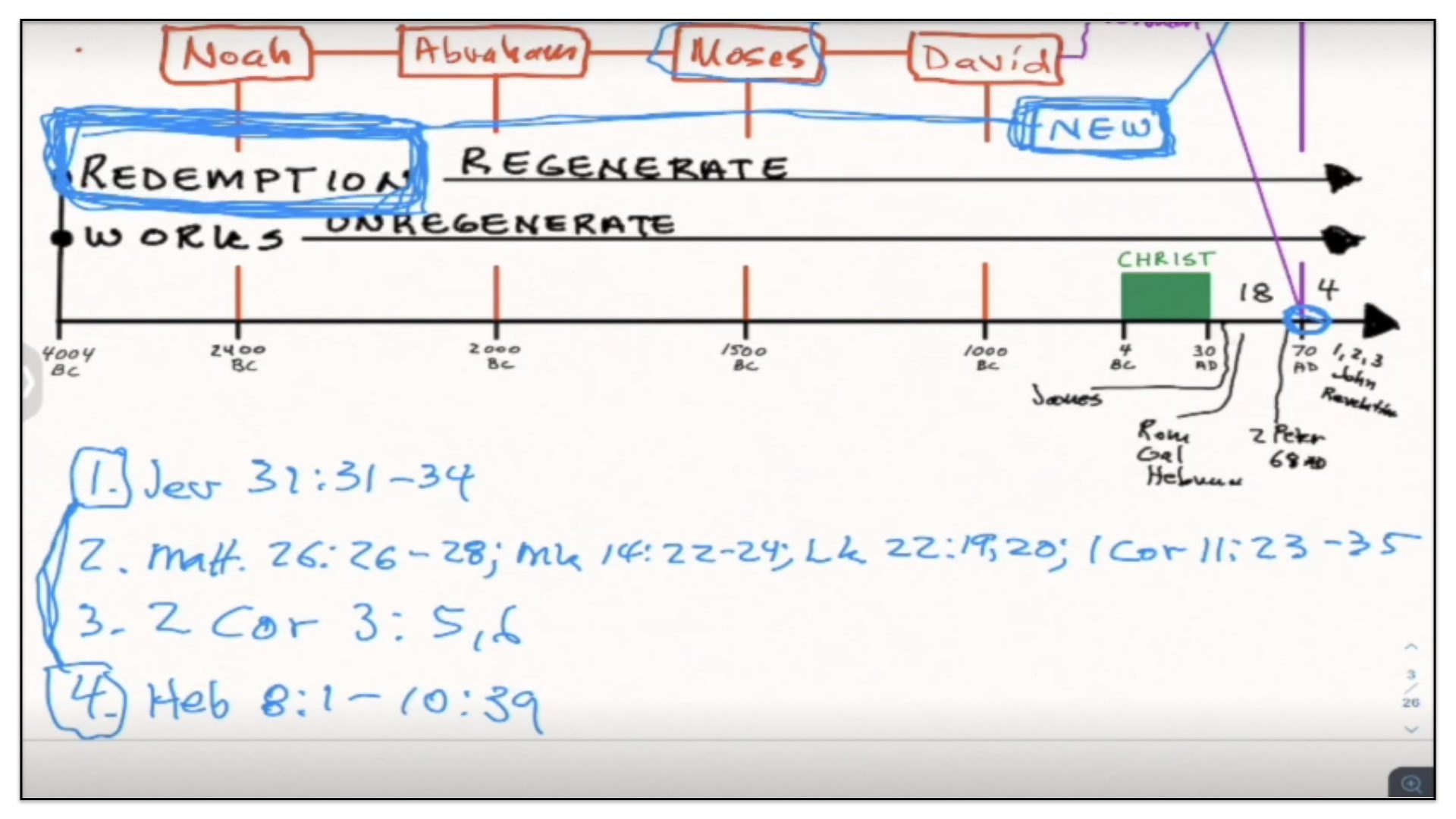
Alright. Well this brings us to the final passages of scripture where reference is made to a New Covenant. And the remainder of these references are to be found in Paul’s epistle to the Hebrews. The first of these passages actually contains three separate references to the New Covenant. However, since they belong to a single context of scripture, I’ve grouped them together. The first part of this passage begins in Hebrews chapter 8 and verse 1 and it ends in chapter 10 and verse 39. Now this passage is actually the New Testament equivalent to Jeremiah chapter 31. This is the commentary of Jeremiah chapter 31. The Apostle Paul is going to quote from Jeremiah 31 in Hebrews chapters 8 through 10.
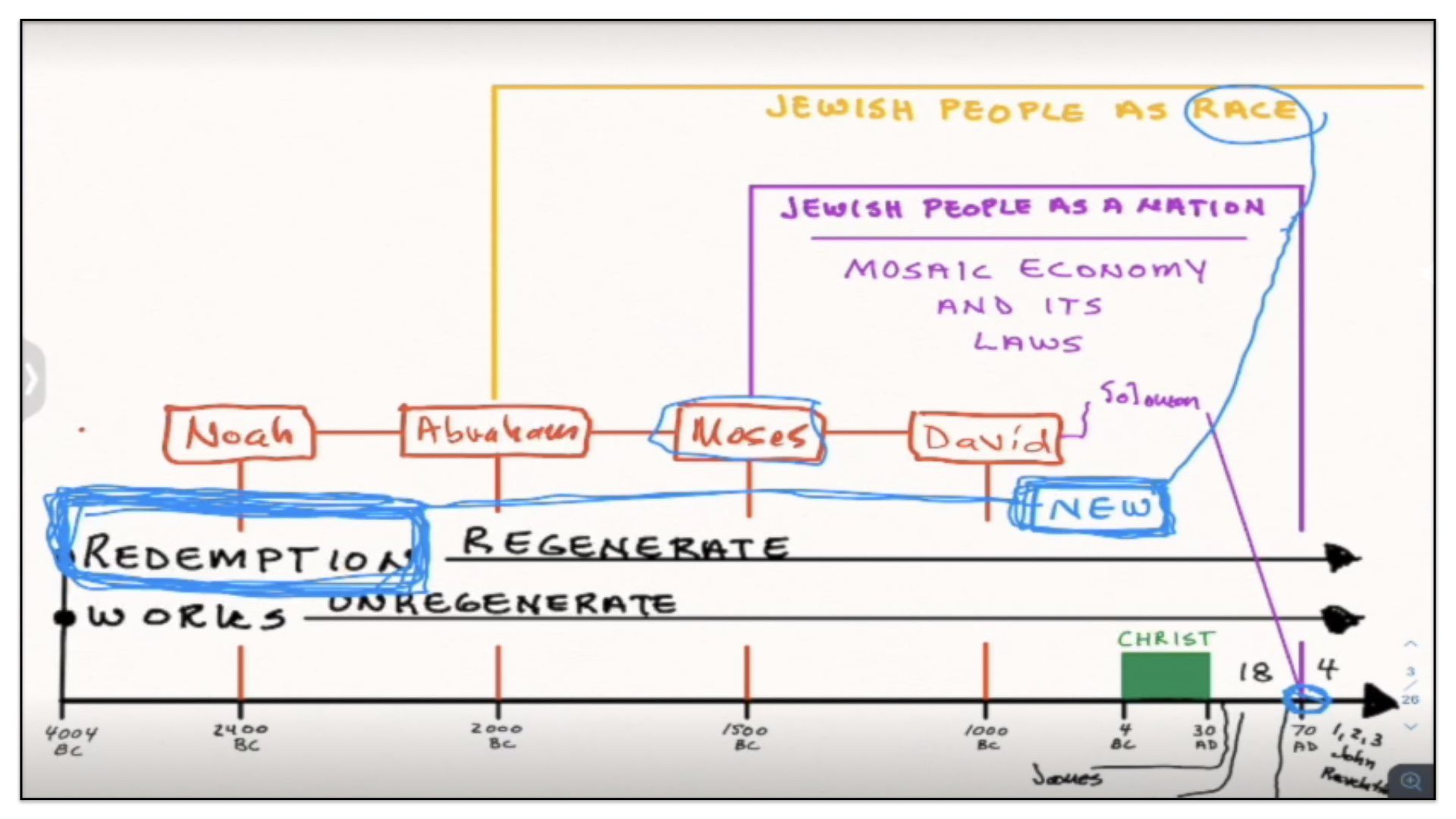
And Paul will explain the very things I’ve sought to explain by using this timeline and this diagram. I’d like to read to you the places where this term appears, this expression appears, within this passage. But of course, I don’t have time to read all of these chapters and so I’m going to read first, Hebrews chapter 8 and you’ll see within the context how Paul explains this timeline and diagram while quoting from Jeremiah chapter 31. And then I will read one passage from Hebrews chapter 9 where he makes reference to a New Covenant again. There’s no need by the way for me to give you a running commentary on these verses. They really do speak for themselves. As I read them, Just keep in mind the backdrop I’ve given to you from this timeline and the diagram. So turn with me to Hebrews chapter 8 and I’ll begin reading in verse 1:
“Now of the things which we have spoken this is the sum: We have such an high priest, who is set on the right hand of the throne of the Majesty in the heavens; A minister of the sanctuary, and of the true tabernacle, which the Lord pitched, and not man. For every high priest is ordained to offer gifts and sacrifices: wherefore it is of necessity that this man have somewhat also to offer. For if he were on earth, he should not be a priest, seeing that there are priests that offer gifts according to the law: Who serve unto the example and shadow of heavenly things, as Moses was admonished of God when he was about to make the tabernacle: for, See, saith he, that thou make all things according to the pattern shewed to thee in the mount. But now hath he obtained a more excellent ministry, by how much also he is the mediator of a better covenant, which was established upon better promises.” This better covenant with better promises, my dear friends, this is a reference to the Covenant of Redemption. The other covenant spoken of is a reference to the covenant God made with Moses. A comparison is made between the two here. Verse 7:
“For if that first covenant had been faultless,” the covenant God made with Moses. Simply meaning, if the covenant God made with Moses was spiritual and perpetual,
“then should no place have been sought for the second,” for the Covenant of Redemption, which is spiritual and perpetual.
“For finding fault with them, he saith, Behold, the days come, saith the Lord,”and here is the quote now from Jeremiah 31, “when I will make a new covenant with the house of Israel and with the house of Judah: not according to the covenant,” the Covenant of Moses, “that I made with their fathers in the day when I took them by the hand to lead them out of the land of Egypt; because they continued not in my covenant, and I regarded them not, saith the Lord. For this is the covenant that I will make with the house of Israel after those days, saith the Lord;” meaning after the destruction of Jerusalem, after the death of Christ. “I will put my laws into their mind, and write them in their hearts: and I will be to them a God, and they shall be to me a people,” meaning that though the Jewish people as a nation has come to an end, yet the Jewish people as a race continues and God has not cast all of them away, for there is a remnant of the Jewish race according to election. They are under the spiritual Covenant of Redemption. In the third branch of the Covenant of Redemption is here mentioned—the work of the Holy Spirit uniting the soul with Christ and imparting to us a new nature, where the gospel law is written upon our hearts. Verse 11:
“And they shall not teach every man his neighbour, and every man his brother, saying, Know the Lord: for all shall know me,” that is, when we’re born again we truly will know the Lord from our hearts, “from the least to the greatest. For I will be merciful to their unrighteousness, and their sins and their iniquities will I remember no more,” a reference to the second branch of the Covenant of Redemption—the redeeming work of the Lord Jesus Christ.
“In that he saith, A new covenant, he hath made the first old. Now that which decayeth and waxeth old is ready to vanish away.” And here you have the next reference to the New Covenant, but I will have you notice in verse 13, the word covenant is italicized, which in the AV translation means that is not a word found in the original Greek. So technically, all we have here is a reference to this—in that he saith a new, he has made the first old. It was the translators of the AV that included the word covenant in order to make the meaning of the verse have more sense for our understanding, and of course, we have no dispute that in verse 13, this is a reference to the New Covenant. But as I’ve said, not a New Covenant in the sense that God is establishing an actual covenant in history.
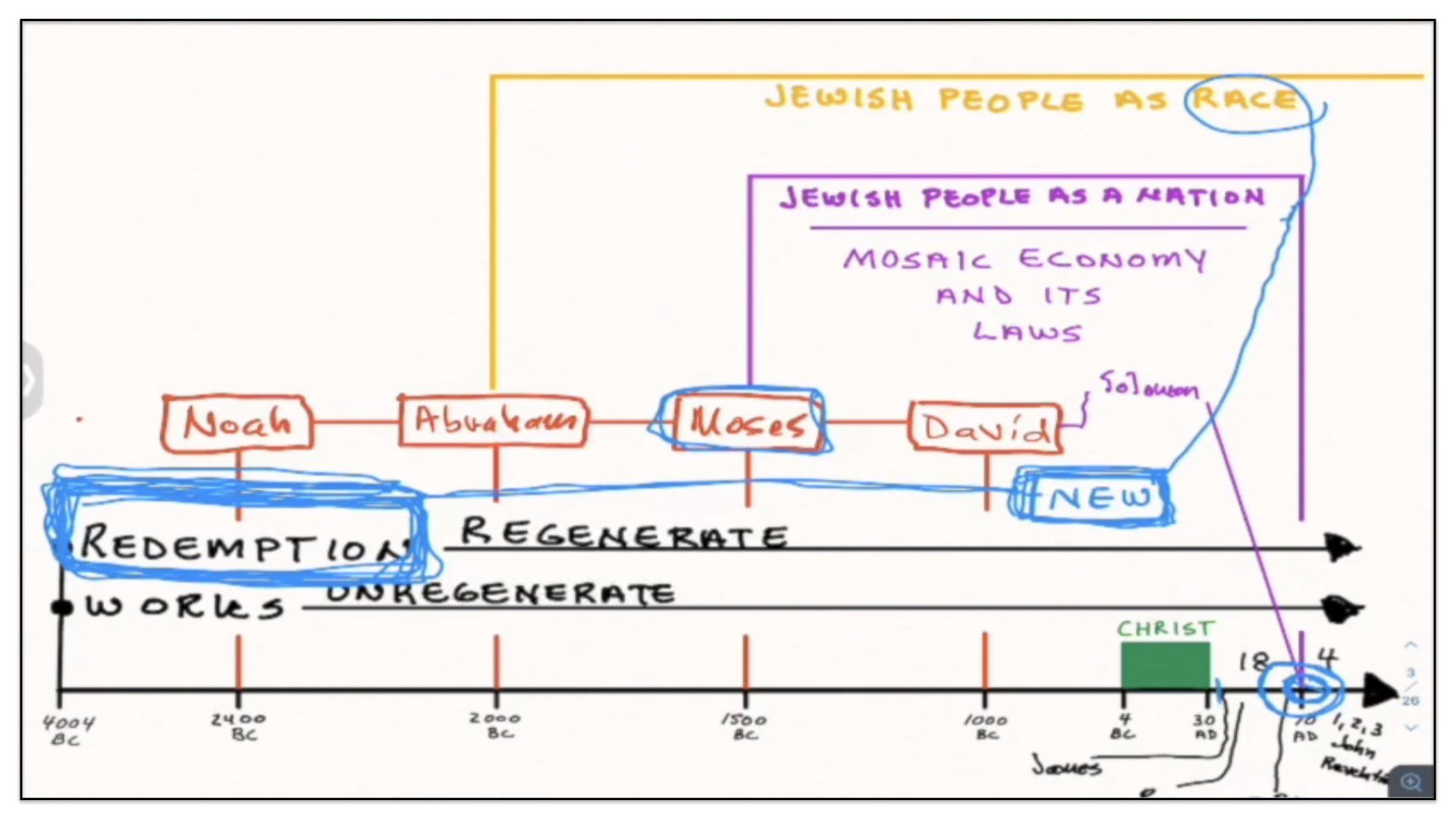
But a New Covenant only in the sense that this is a spiritual and perpetual covenant that transcends the covenant God made with Moses. And when the covenant God made with Moses comes to an end in 70 AD, or with the death of Christ, this Covenant of Redemption continues. And in that sense, it’s new from the perspective, from the perspective of the Jewish people as a race or as a nation.
The other time it’s mentioned within this general context—a New Covenant—is found in Hebrews chapter 9 and I’d just like to begin reading for you in verse 13. Hebrews chapter 9 and verse 13. And I’ll read down for you to verse 15:
“For if the blood of bulls and of goats, and the ashes of an heifer sprinkling the unclean, sanctifieth to the purifying of the flesh: How much more shall the blood of Christ, who through the eternal Spirit offered himself without spot to God, purge your conscience from dead works to serve the living God? And for this cause he is the mediator of the new testament (or the new covenant), that by means of death, for the redemption of the transgressions that were under the first testament (or covenant),” this would be a reference to the Covenant of Moses, “they which are called might receive the promise of eternal inheritance.” Again, the language speaks for itself. This is not a New Covenant God was then establishing in history with Israel or with anyone, but rather, it is an explanation of the second branch of the Covenant of Redemption, which when the fullness of time was come, God brought to pass by sending forth His only begotten Son.
Hebrews 12:22-24
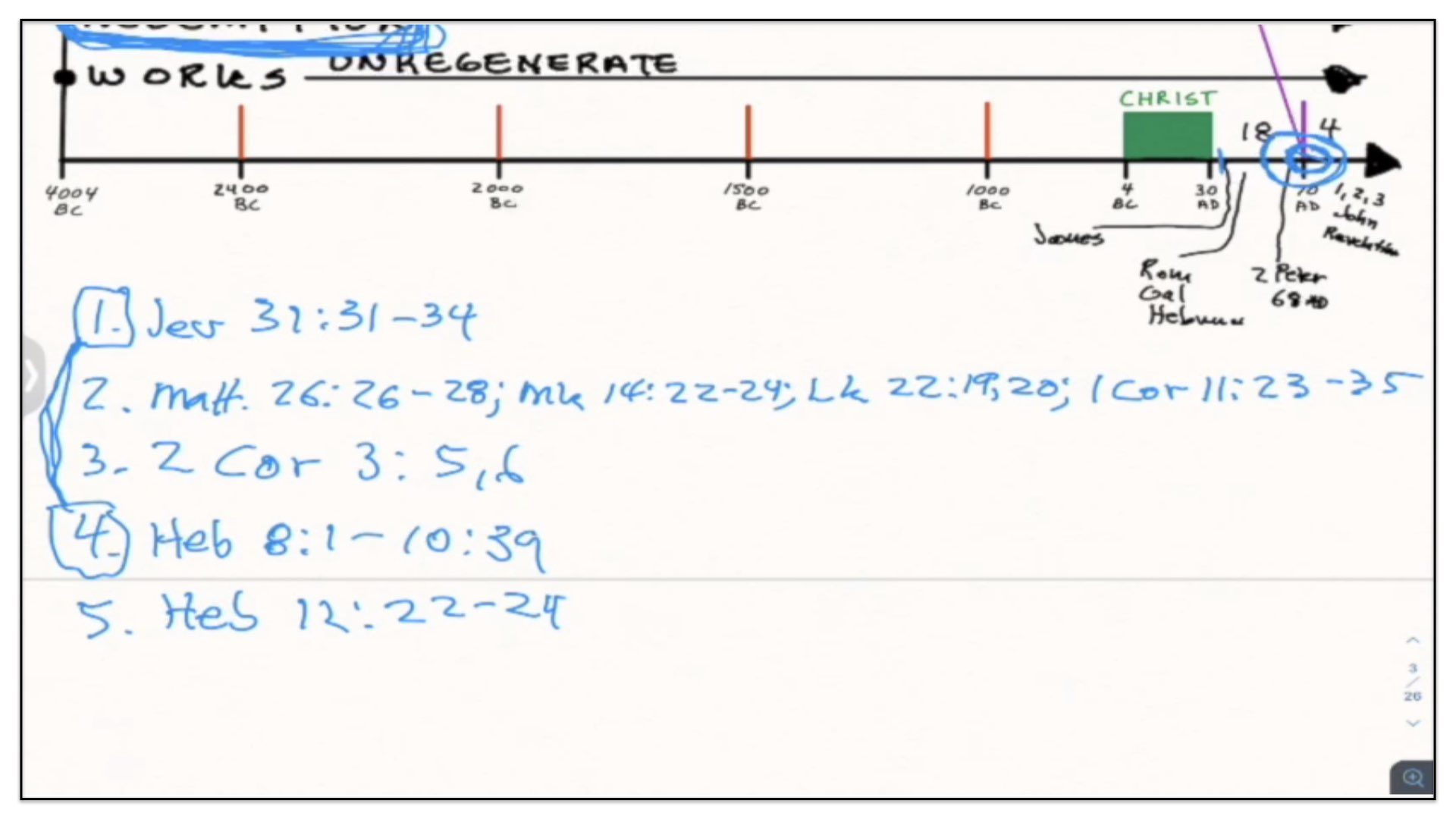
Well, this then brings us—look, these are the passages where we find a reference to the New Covenant—this brings us to the final passage. It’s also found in Hebrews. It’s found in Hebrews chapter 12, verses 22 through 24. And here Jesus is called the Mediator of the New Covenant. Allow me to read for you this passage. Again, we’re reading in Hebrews chapter 12 and beginning in verse 22. I’ll read down to verse 24:
“But ye are come unto mount Sion, and unto the city of the living God, the heavenly Jerusalem, and to an innumerable company of angels, To the general assembly and church of the firstborn, which are written in heaven, and to God the Judge of all, and to the spirits of just men made perfect, And to Jesus the mediator of the new covenant,” there’s the language—Jesus the Mediator of the new covenant, “and to the blood of sprinkling, that speaketh better things than that of Abel.” This is a reference, my dear friends, to the consummation of all things.
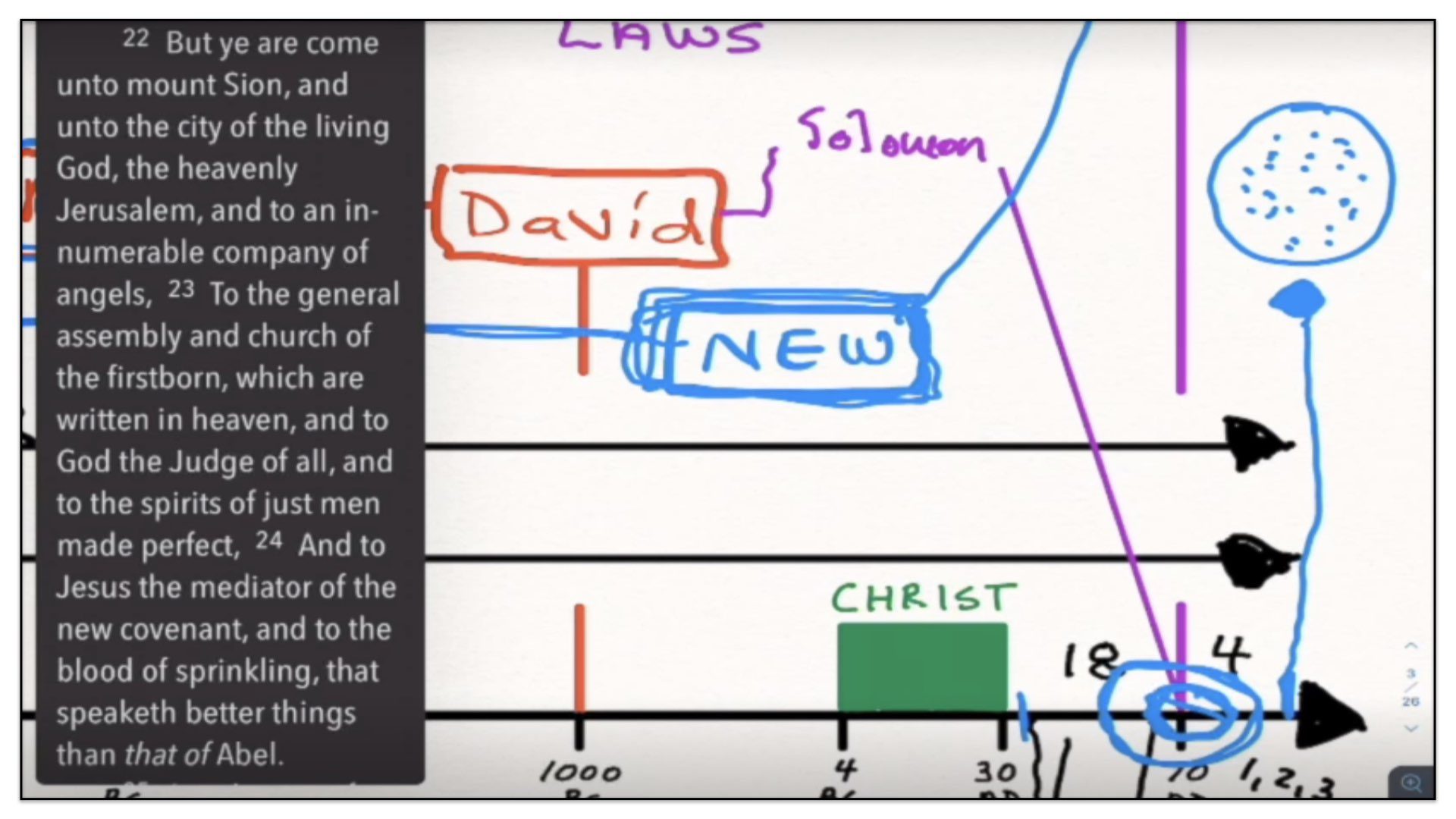
The consummation of all things is going to happen somewhere here. I’m just drawing a line up. We’re living in 2023. Now, the consummation of all things will occur when Christ returns. And that’s what Paul is now speaking of in Hebrews chapter 12. When Christ returns to this earth, He will gather all of His spiritually elect people together, and they will all be given glorified bodies. And truly this will be the general assembly and church of the firstborn, when Christ gathers His elect people together. And all of His elect people will have access to God through Jesus, Who is the Mediator of the new covenant.
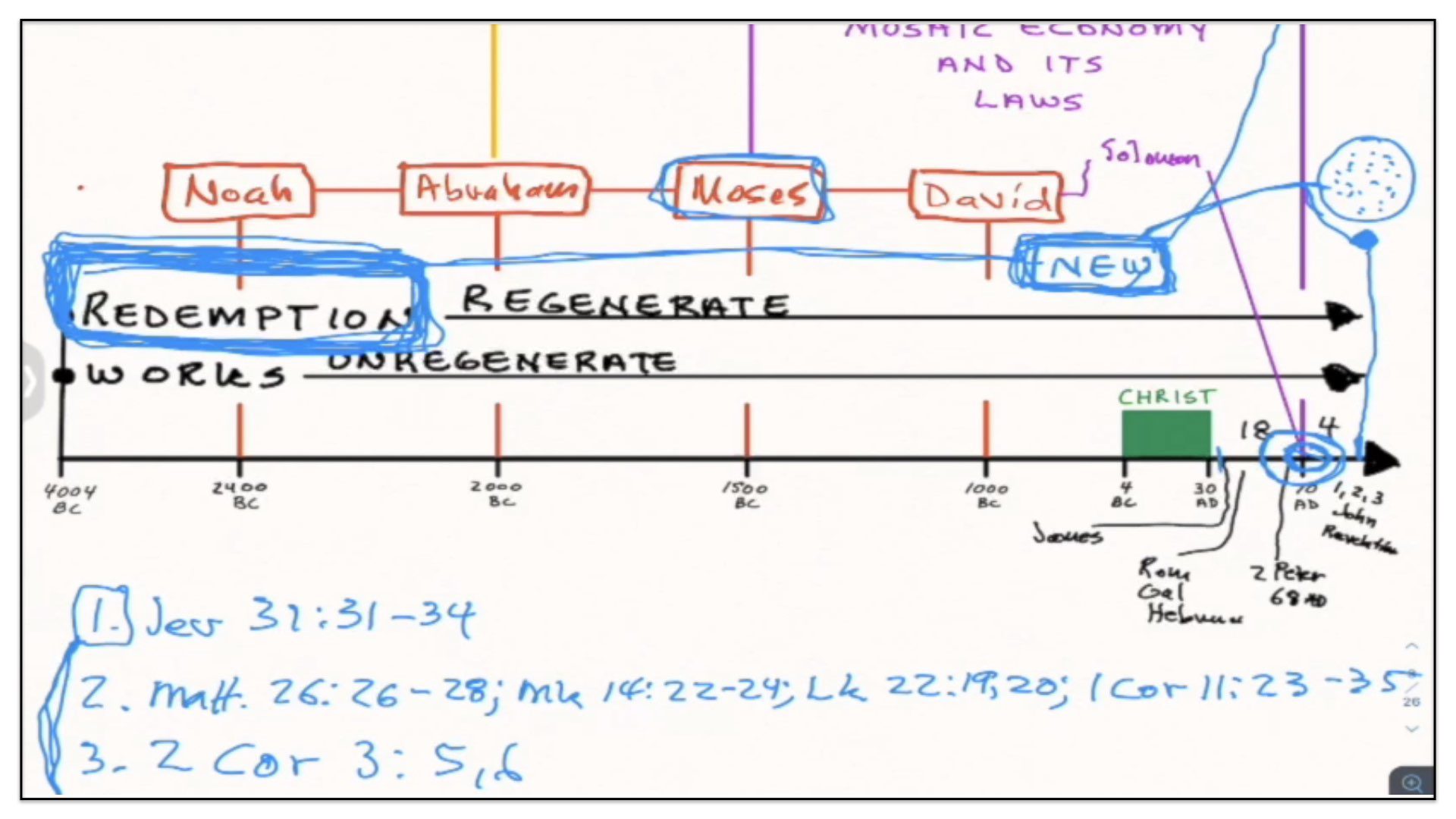
What does this mean, the Mediator of the new covenant? Jesus, of course, is the Mediator of the Covenant of Redemption. The Covenant of Redemption is that agreement made between the Father and the Son—the Father appointing His Son to serve as the Redeemer for the elect, the Son receiving the elect unto Himself and agreeing to redeem them. This is the engagement between the Father and Son in the Covenant of Redemption. And in this way, it’s the Lord Jesus Christ who is the Mediator of this Covenant of Redemption. And it’s through the mediation of the Lord Jesus Christ that we have access to God. And that’s the meaning of the Lord Jesus being a Mediator of the new covenant. It’s an explanation of the Covenant of Redemption; it’s not an actual covenant that God established in history apart from the Covenant of Redemption. Oh, no! It is the Covenant of Redemption explained to the Jewish people as a nation who were then living under the Mosaic economy and its laws.
A Closing Explanation
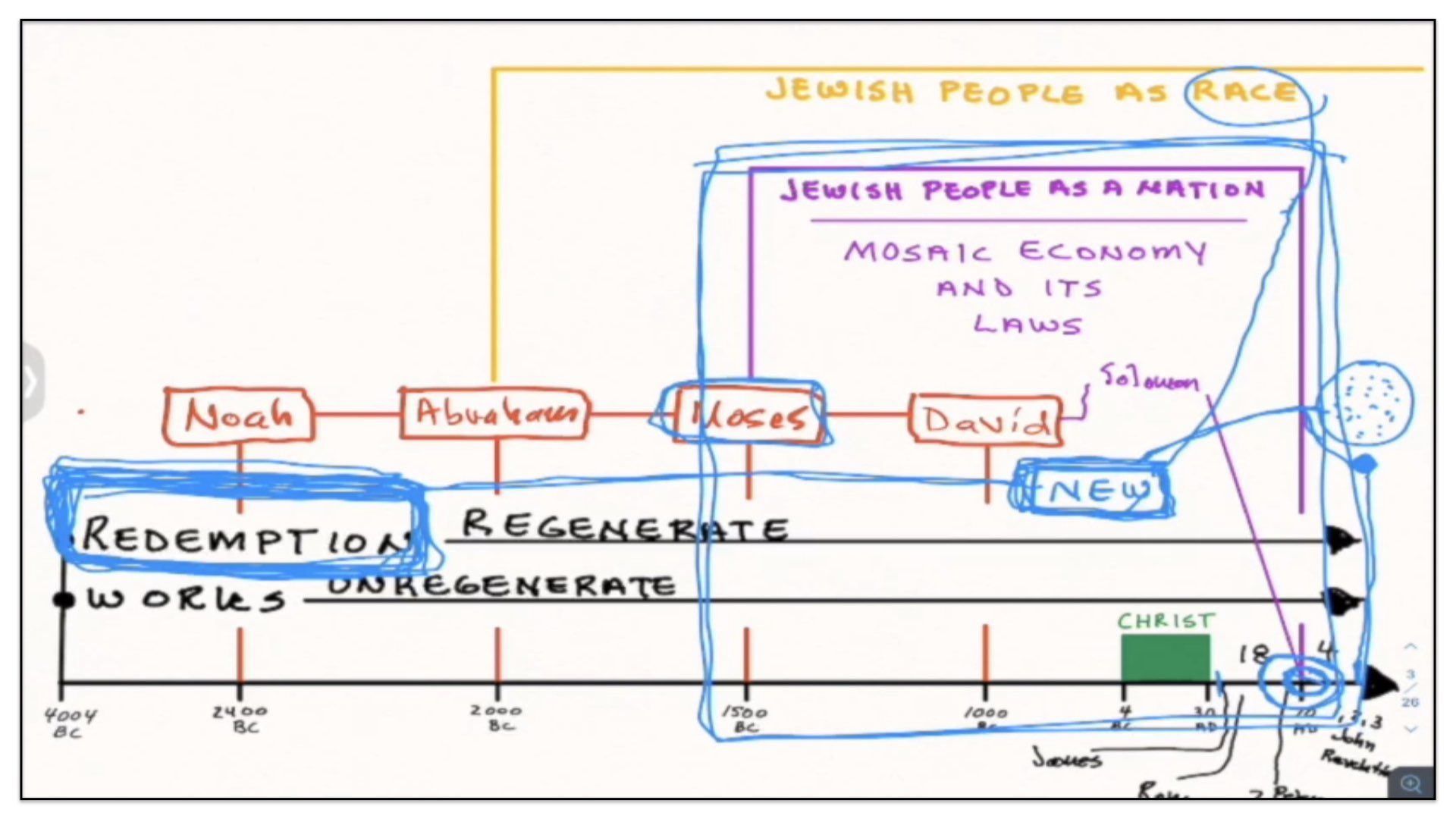
Well, my dear friends, these are the biblical references we have to a New Covenant and I’ve done my very best to explain as clearly as I can that these are all pointing towards a basic explanation to a group of people that were living under a special covenant of history and before that covenant came to an end,
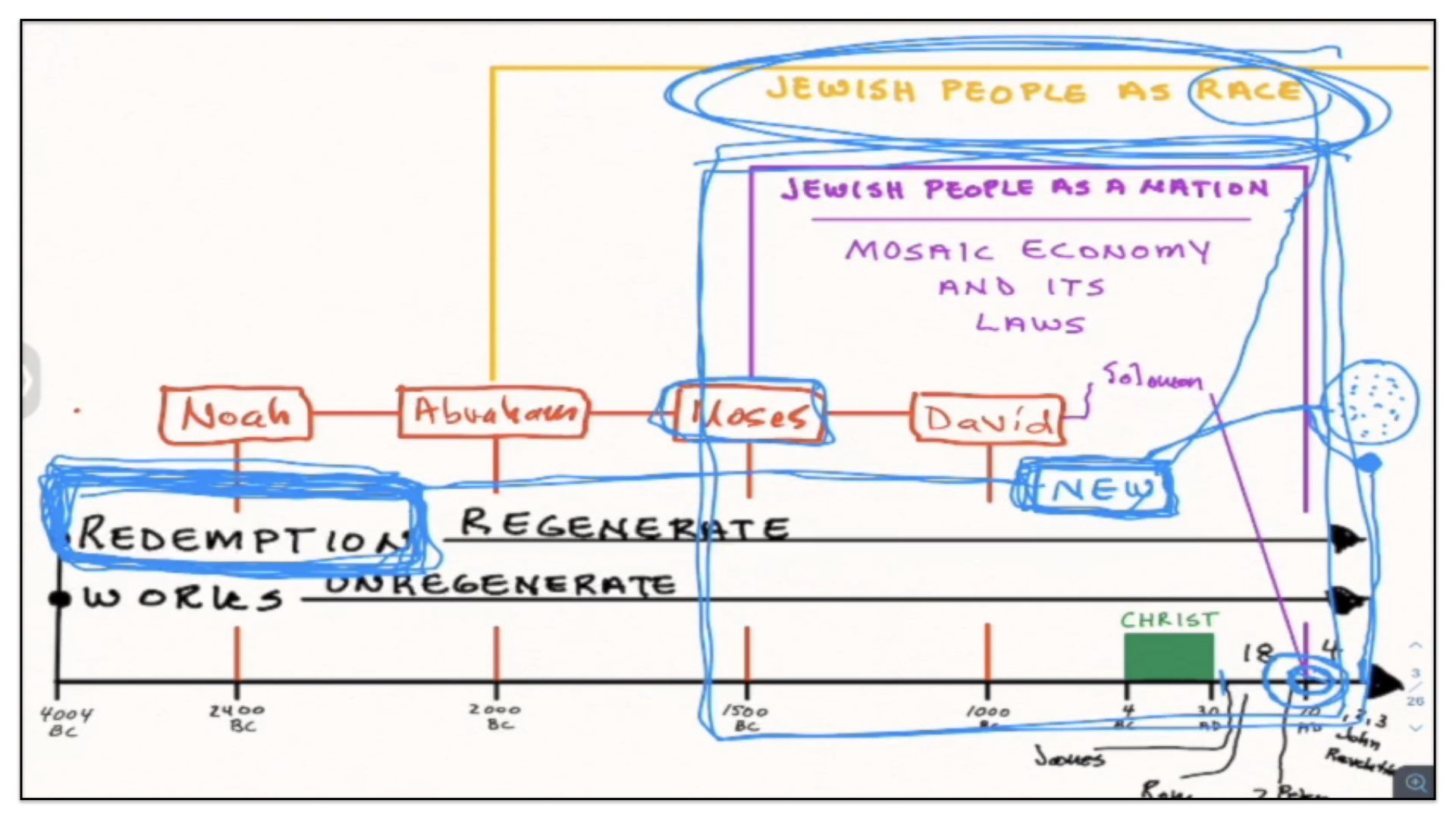
God is simply giving to them an explanation that their race is not coming to an end.
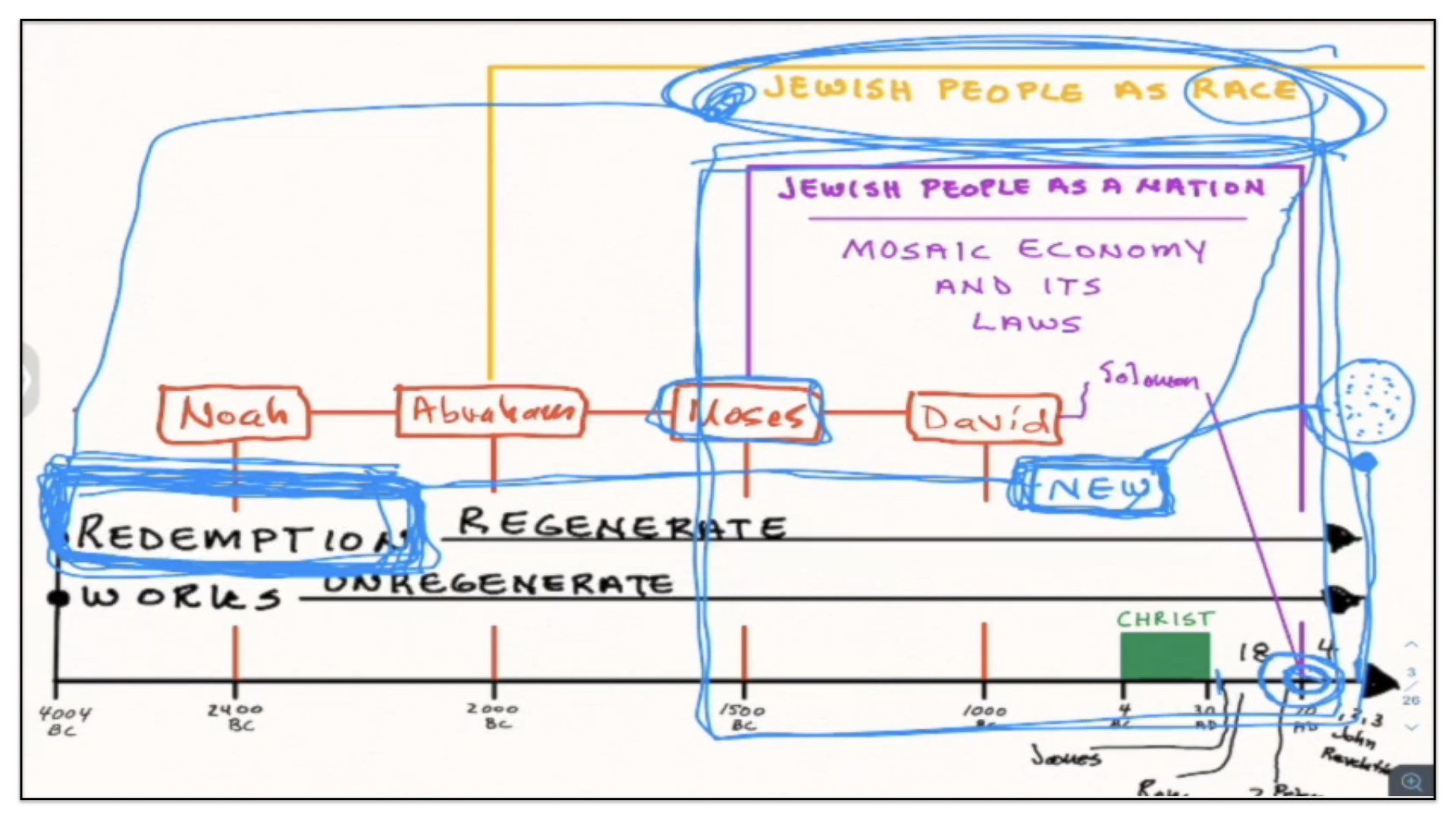
That God’s purpose in redemption continues and a remnant of the Jewish people according to electing grace are included as recipients under the Covenant of Redemption.
A Final Word
Well, that’s it. That’s my teachings on a New Covenant. But I see the time and I have to close this study. I haven’t finished everything I wanted to say about the New Covenant. I still want to make an emphasis on the view that I maintain on this subject compared to some of the leading or popular views of other groups, particularly that of the Presbyterians and that of the Reformed Baptists. They have very different views than myself on this topic. And I think it would be helpful, for you to better understand my teachings, if I were to bring another study on comparing my teachings on the New Covenant with the teachings of the Presbyterians and the Reformed Baptists on the same topic. So join me again next time for another study on the New Covenant when I will make a comparison between my view and that of others.
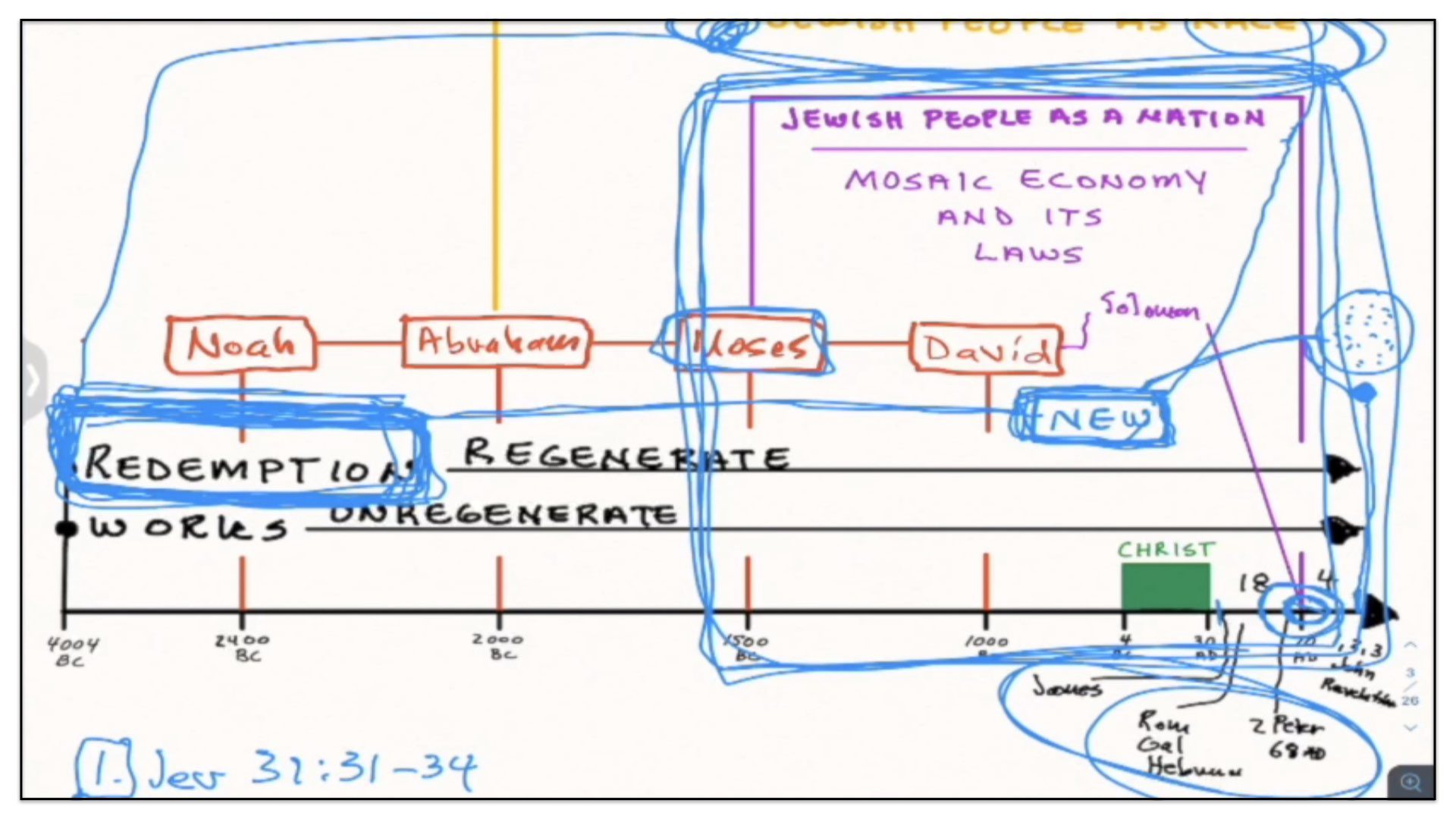
Until then, I’d like to wish upon you every blessing of the Lord and I do hope that the teachings I’ve given to you for this study will be an enrichment to your soul as you continue to study the New Testament scriptures and you’ll begin to interpret them, perhaps a little different now that you can see how and why Paul and Peter, James and Jude were writing the things they were writing within the context of this diagram and timeline.
Alright, my friends, God bless you.
Jared Smith served twenty years as pastor of a Strict and Particular Baptist church in Kensington (London, England). He now serves as an Evangelist in the Philippines, preaching the gospel, organizing churches and training gospel preachers.
Jared Smith's Online Worship Services
Jared Smith's Sermons
Jared Smith on the Gospel Message
Jared Smith on the Biblical Covenants
Jared Smith on 18th Century Covenant Theology (Hyper-Calvinism)
Jared Smith on the Gospel Law
Jared Smith on Bible Doctrine
Jared Smith on Bible Reading
Jared Smith's Hymn Studies
Jared Smith on Eldership
Jared Smith's Studies In Genesis
Jared Smith's Studies in Romans
Jared Smith on Various Issues
Jared Smith, Covenant Baptist Church, Philippines
Jared Smith's Maternal Ancestry (Complete)




